- Link to facebook
- Link to linkedin
- Link to twitter
- Link to youtube
- Writing Tips

How and When to Use Images in an Essay
3-minute read
- 15th December 2018
Pages of text alone can look quite boring. And while you might think that ‘boring’ is normal for an essay, it doesn’t have to be. Using images and charts in an essay can make your document more visually interesting. It can even help you earn better grades if done right!
Here, then, is our guide on how to use images in an academic essay .
How to Use Images in an Essay
Usually, you will only need to add an image in academic writing if it serves a specific purpose (e.g. illustrating your argument). Even then, you need to make sure images are presently correctly. As such, try asking yourself the following questions whenever you add an image in an essay:
- Does it add anything useful? Any image or chart you include in your work should help you make your argument or explain a point more clearly. For instance, if you are analysing a film, you may need to include a still from a scene to illustrate a point you are making.
- Is the image clearly labelled? All images in your essay should come with clear captions (e.g. ‘Figure 1’ plus a title or description). Without these, your reader may not know how images relate to the surrounding text.
- Have you mentioned the image in the text? Make sure to directly reference the image in the text of your essay. If you have included an image to illustrate a point, for instance, you would include something along the lines of ‘An example of this can be seen in Figure 1’.
The key, then, is that images in an essay are not just decoration. Rather, they should fit with and add to the arguments you make in the text.
Citing Images and Illustrations
If you have created all the images and charts you want to use in your essay, then all you need to do is label them clearly (as described above). But if you want to use an image found somewhere else in your work, you will need to cite your source as well, just as you would when quoting someone.
The exact format for this will depend on the referencing system you’re using. However, with author–date referencing, it usually involves giving the source author’s name and a year of publication:

In the caption above, for example, we have cited the paper containing the image and the page it is on. We would then need to add the paper to the reference list at the end of the document:
Find this useful?
Subscribe to our newsletter and get writing tips from our editors straight to your inbox.
Gramblička, S., Kohar, R., & Stopka, M. (2017). Dynamic analysis of mechanical conveyor drive system. Procedia Engineering , 192, 259–264. DOI: 10.1016/j.proeng.2017.06.045
You can also cite an image directly if it not part of a larger publication or document. If we wanted to cite an image found online in APA referencing , for example, we would use the following format:
Surname, Initial(s). (Role). (Year). Title or description of image [Image format]. Retrieved from URL.
In practice, then, we could cite a photograph as follows:
Booth, S. (Photographer). (2014). Passengers [Digital image]. Retrieved from https://www.flickr.com/photos/stevebooth/35470947736/in/pool-best100only/
Make sure to check your style guide for which referencing system to use.
Need to Write An Excellent Essay?
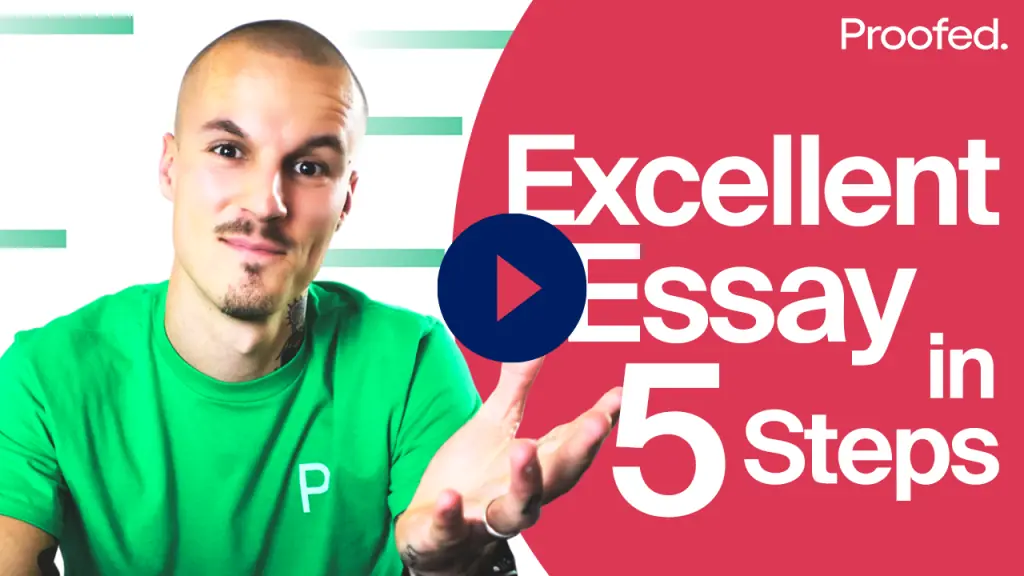
Share this article:
Post A New Comment
Get help from a language expert. Try our proofreading services for free.
4-minute read
The Benefits of Using an Online Proofreading Service
Proofreading is important to ensure your writing is clear and concise for your readers. Whether...
2-minute read
6 Online AI Presentation Maker Tools
Creating presentations can be time-consuming and frustrating. Trying to construct a visually appealing and informative...
What Is Market Research?
No matter your industry, conducting market research helps you keep up to date with shifting...
8 Press Release Distribution Services for Your Business
In a world where you need to stand out, press releases are key to being...
How to Get a Patent
In the United States, the US Patent and Trademarks Office issues patents. In the United...
The 5 Best Ecommerce Website Design Tools
A visually appealing and user-friendly website is essential for success in today’s competitive ecommerce landscape....

Make sure your writing is the best it can be with our expert English proofreading and editing.

- Customer Reviews
- Extended Essays
- IB Internal Assessment
- Theory of Knowledge
- Literature Review
- Dissertations
- Essay Writing
- Research Writing
- Assignment Help
- Capstone Projects
- College Application
- Online Class
When to Use an Image in an Essay: What You Need to Know
by Antony W
September 13, 2022
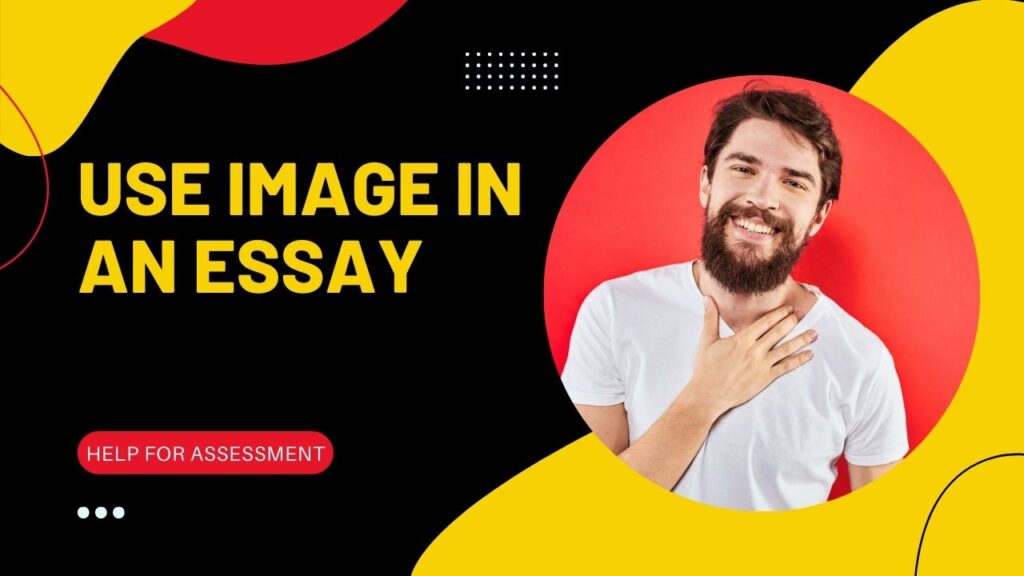
There’s a 98% chance that the essays you’ve written so far are pages of text alone. While plain text can make the work look dull, academic writing hardly ever requires you to use images, charts, and graphs in the essay.
While that doesn’t mean you can’t include visuals in your assignment, it’s important to learn when to use an image in an essay.
You can add an image in your essay only if it serves a specific purpose such as illustrating an argument for more clarity. If you’re going to include an image in your essay, make sure you present it correctly and at the same time follow the standard citation rules.
In this guide, we’ll talk more about images in an essay, including why they’re important, when exactly to add one in your work, and the right way cite them.
In the end, you should be able to make a solid judgment as far as the inclusion of images in your work is concerned.
Key Takeaways
- The types of images you can use in an essay are pictures, graphs, and charts.
- It’s acceptable to add an image in an essay to illustrate an argument for more clarity.
- Images can be useful when explaining a process, showing an example, or in the instance when you want to grab your reader’s attention.
- Be advised that you must follow the accepted citation rules when including an image in the essay.
What Type of Images Can You Include in An Essay?
Just because you can include an image in an essay doesn’t mean any image you include in the assignment will be a good fit.
Remember, the role of an image is to give your essay a better structure and make your writing readable and easy to understand.
Instructors don’t impose limits on the types of images a student can include in an essay.
For example, a student working on an IB Physics Internal Assessment can use charts, drawings, photos, and infographic to explain concepts that would be otherwise difficult to explain in words.
However, there are rule you must observe.
1. Pictures
Pictures introduce breaks between blocks of words in an essay while adding meaning to the overall context of the assignment.
By themselves, pictures are worth a thousand words, which is another way to state that they’re descriptive enough to communicate a solid message.
While you can use any picture in your essay, provided it’s relevant for your topic, the image you choose to include must have meet the following requirements:
- The image should be clear when viewed in web document and in print
- You must have the legal right to use the image in your essay – otherwise you’d have to create your own
- The image you choose should be relevant to the topic of your essay
The next thing you need to understand before including an image in an essay is placement .
In other words, where should you insert the picture?
- End of the essay: Include the image in the reference section of your essay and then include a reference to the image in the body text of your essay.
- In the body of the essay: Have the image inserted on a separate page within the body section of your essay. Don’t forget to mention the picture in the text so that your readers are aware that you’ve intentionally included it in your work.
- Within body text: You can use in-text citations to include an image in your essay, but it’s best to avoid this option because it tends to alter the formatting of the paper.
The picture you include in your essay must have a source name, unique description, and a number to make it easy for your reader to find and reference the image if they want to.
Also, you should attribute the photo if you don’t own it so that you don’t violate the copyright ownership of the material.
2. Graphs and Charts
Graphs and charts are the best type of media to include in an essay.
Unlike standard pictures, graphs and charts can easily explain complex concepts in visuals than lengthy words would do. These types of images are useful because they can help you to:
- Illustrate size, meaning, or a degree of influence
- Compare two or more objects
- Provide an illustration of some statistics that are relevant to your study
The best thing about using graphs and charts in an essay is that you can explain complex concepts and make them easily understood.
So whether you want to show a comparison or believe that graphs and charts can communicate ideas better than words, you can add some visualization to your work to make your essay appear more appealing and easier to read.
You can use ready-made graphs and charts in your work provided you cite them properly.
Or you can use a software solution such as Microsoft PowerPoint to create your own.
Whether you download your media from the web or create them on your own, it’s important that you add appropriate naming and comments to enhance information clarity.
Get Essay Writing Help
If you haven’t started your essay because you have many other assignments to complete, you can hire our essay writers to help you get the work done fast.
We help with topic selection, research, custom writing, editing and proofreading at an affordable price.
When to Use an Image in an Essay
The following are instance of when it would make sense to use an image in an essay:
1. When Explaining a Process
Some processes are difficult to explain because they are complex.
If you don't think words can adequately convey meaning or the message you wish to communicate, it would be best to use an image to simplify your explanations and bring out meaning.
2. If You Want to Show an Example
Any claim you make in your article or research paper must include proofs and specific examples.
To reinforce your argument, you might provide a graphic or chart as an easy-to-understand illustration.
Let’s say you want to talk about the effects of various medications on bacteria.
In such a case, it would make more sense to use a before-and-after photographs or graphs to illustrate your point.
3. Images Are Useful for Grabbing Reader’s Attention
You can use graphic pictures to draw the attention of your readers. When writing on works of art and cultures, it would make a lot of sense to include images in your piece of writing.
Final Thoughts
To be abundantly clear, images aren’t a requirement in essay writing.
So you should only include them if they serve unique and academically acceptable purpose.
You don’t want to add an aesthetic appeal to your essay when really there’s no need for you to do so in the first place.
About the author
Antony W is a professional writer and coach at Help for Assessment. He spends countless hours every day researching and writing great content filled with expert advice on how to write engaging essays, research papers, and assignments.
17.1 “Reading” Images
Learning outcomes.
By the end of this section, you will be able to:
- Define the key concepts and elements of visual rhetoric.
- Interpret visual information using the language of visual rhetoric.
- Interpret images differently based on cultural considerations.
- Choose digital and visual media according to the rhetorical situation and cultural context when writing for different audiences.
- Make informed decisions about intellectual property issues regarding images.
To compose an effective essay or a strong visual, a creator works with a number of elements that are remarkably similar from one medium to the other. Both stories and pictures contain information presented by a creator who has a particular point of view and arranges the work in two-dimensional space. The information is likely to be open to multiple interpret , which may or may not be justified by the text. Although the sharing of personal opinions and beliefs has value, the focus here is on interpreting or analyzing texts in combination with your personal experiences.
Interpreting Visual Information
Both words and pictures convey information, but each does so in different ways that require interpretation. Interpretation is the sense a person makes of a piece of communication—textual, oral, or visual. It includes personal experience, the context in which the communication is made, and other rhetorical elements. (See Glance at Genre: Relationship Between Image and Rhetoric for a list of key terms related to visual elements and rhetoric.) By the time readers get to college, they have internalized strategies to help them critically understand a variety of written texts.
Images present a different set of challenges for critical readers. For example, in a photograph or drawing, information is presented simultaneously, so viewers can start or stop anywhere they like. Because visual information is presented in this way, its general meaning may be apparent at a glance, while more nuanced or complicated meanings may take longer to figure out and likely will vary from one viewer to another.
Some images, however, do not really lend themselves to interpretation. Before trying to engage in rhetorical discourse about an image, be sure it contributes something of value. For example, Figure 17.2 shows a punk rock concert featuring the band Naked Raygun with several concertgoers in the foreground. Such pictures are common forms of memorabilia that serve an archival function. The features common to visual rhetoric—point of view, arrangement, color, and symbol—do not inspire much in the way of discussion in this particular image. Parts are blurry, some of the figures are obscure, and the picture’s purpose is unclear. Therefore, any analysis of the image may be guided more by personal opinion than by critical thinking. Such images are not the focus of this chapter.
Figure 17.3 , in contrast, depicts not merely a moment in time for the sake of memory, although it certainly does that. It contains a central, dominant figure. The color red is bold and centers the figure, giving the image weight. It also conveys several political messages, both obvious and nuanced. The woman in the picture is wearing a mask, as people were either asked or mandated to do during the COVID-19 pandemic. The slogan on her mask reads “I can’t breathe,” words that were made infamous after Eric Garner (1970–2014) died as the result of an illegal chokehold inflicted by a New York City police officer during arrest. These words were repeated by George Floyd (1973–2020) in an 8-minute, 46-second video showing his murder by a Minnesota police officer who knelt on Floyd’s neck. The phrase became one of several slogans of the Black Lives Matter (BLM) movement, symbolizing the struggle that people of color endure when living in an implicitly and explicitly racist culture. Breathing—like blood—is fundamental, essential. Without breath, there is no life. Thus, this slogan draws attention to the fact that people of color may be brutalized for no reason other than their existence.
Placing the slogan on a mask is a design choice likely to provoke those who have argued against mandated mask wearing as an assault on personal liberty and who have proclaimed they could not breathe while wearing masks. Juxtaposition , or placing contrasting elements close together, is a technique that image creators often use for a variety of purposes: humor, irony, sarcasm, or—as in this case—disgust or outrage. The juxtaposition of the mask with a slogan referencing literal asphyxiation emphasizes the wearer’s view that state violence against people of color is a more serious threat to her existence than a mask. Thus, the image is open to multiple interpretations.
Thinking Critically
To think critically about visual information, first identify the objects, facts, processes, or symbols portrayed in the image. Taking all the information together, ask whether there is a main or unifying idea. Is the meaning open to multiple interpretations? Is it suggested but not stated? Is it clear and unambiguous? Are there multiple levels of meaning, both stated and unstated? When you view an image, pausing to answer such questions will sharpen your critical faculties, increase your understanding of the visual information you encounter, and help you use images more meaningfully in texts you create.
Visual Rhetoric
Written texts rely on strategies such as thesis statements, topic sentences, paragraphing, tone, and sentence structure to communicate their message to their audience. Images rely on different strategies, including point of view , arrangement , color , and symbol . When writing about images or including them in your writing, think critically about the visual strategies they use and the effect they will have on your audience.
Using these techniques may or may not make you a proficient artist or creator of images. However, familiarity with the technical language of the visual arts will certainly enable you to describe what you observe as you build the evidence that allows you to interpret an image, reflect on it, analyze it, and make persuasive arguments about it.
Point of View
In written texts, point of view refers to the “person” from whose vantage point the information is delivered, either a character in the story or a narrator outside the story. However, in photographs, drawings, and paintings, point of view refers to the place from which the image creator looks at the subject—where the photographer places their camera or the artist their easel.
Photographs that haven’t been manipulated in a darkroom or digitally by a computer only reproduce the subject in front of the camera, as it exists in the moment the shutter opens and closes. They do not show anything to the left or right, above or below, or what comes before or after. A camera aimed to the east omits information from the north, west, and south. In other words, any photograph is the result of placing a camera in a certain location, at a certain height and distance, at a specific time of day and using a particular lens, film, and perhaps a filter. All of these decisions about where, when, and how to place the camera create the visual point of view.
You can find good examples of these kinds of limited truths in real-estate advertisements featuring photographs of houses for sale. The photograph might not reveal a landfill next door or a factory across the street—though you might infer such limitations from a low selling price or confirm them by driving past the house.
The creator of Figure 17.4 chooses to highlight the digital waterfall with its seductive lighting and colors. Meanwhile, the people interacting with the computer are barely visible, standing off to the side, some nearly out of the frame. The silhouetted profiles and darkened faces lack identifying details. These features are emphasized by the blurred people in the background. These figures, too, are unidentifiable and are looking out of the frame, uninterested. The effect is to imply that the waterfall and its computer interface dominate human interaction and possibly even human existence.
To think critically about point of view, answer the following questions:
- From what place or stance does the image creator view the subject?
- What effect does this particular point of view have on the way viewers may think or feel about the subject?
- What would happen if the vantage point were elsewhere—above or below, left or right?
- What would change in the image if the point of view were changed?
Arrangement
In addition to point of view, artists use arrangement to signal an image’s significance to the reader. The term arrangement in visual texts might be compared to terms such as order , organization , and structure in verbal texts, though the differences are substantial. While writers arrange , or put together, a story, essay, or poem to take place over time—that is, the time readers need to follow the text, line by line, through a number of pages—image creators arrange pictures in the two-dimensional space of their viewfinder, paper, or canvas to invite viewers to read in space rather than time. This difference is also evident in sculpture and other three-dimensional works, which require viewers to move around them to read them spatially. In visual texts, then, arrangement refers to the ways in which the various parts of a picture come together to present a single coherent experience for the viewer.
In contrast to static images, which are read spatially, videos and some types of multimodal texts—those incorporating more than one genre, discipline, or literacy (for example, GIFs that incorporate pictures or videos with language)—combine elements of both time and space. That is, they invite viewers to examine an image in motion that changes over time. Video creators often mimic linear time by telling a story, or they repeat key images to be interpreted differently after being seen in various contexts within the video.
One element to examine is the use of pattern —predictable, repeated elements within the visual field that the eye notices and seems attracted to. Just as sonnets, sestinas, and haiku follow patterns of lines, so do visual compositions. But in these, patterns are created by light and color rather than words. Documentary and commercial photographers often use visual patterns to lead viewers to an intended meaning. Patterns are especially prominent in street art, where the elements of surrounding architecture and infrastructure interact with the work, as shown in Figure 17.5 .
Many patterns are suggested by mathematics. For example, the Möbius strip is both a mathematical construct and a visual enigma. It has one side and one boundary curve. It looks like a spiral, but it does not intersect itself. Thus, it gives the impression of being infinite. In Figure 17.5 , the artist capitalizes on these features of the Möbius strip, using it to depict the seemingly endless cycle of destruction (green tanks) and reconstruction (yellow steamrollers) in one of the world’s most contested pieces of real estate: the Gaza Strip.
Ownership and control of the Gaza Strip are disputed. Approximately two million people live there, many in refugee camps. Since the mid-20th century, the region has been fought over by Israel, Egypt, and Palestinian Arabs. As you contemplate the mural, think about the way its creator uses pattern and repetition to convey various ideas and emotions. The following questions may help:
- Which elements within the mural are repeated?
- Where is its center of gravity or weight?
- Where do patterns of light/dark, large/small, and color lead the eye?
- How do pattern and balance contribute to meaning in a two-dimensional image?
- What does the arrangement suggest about the meaning of the image?
Color and Symbol
Pattern and arrangement are controlled by the image creator and intended to guide the viewer. Color and symbol allow the viewer greater latitude in interpreting the image, in part because particular colors suggest specific moods. Think about your personal reactions to different colors. What color might you select to paint your bedroom? What is your favorite color for, say, clothing or cars? While these may differ according to personal preference, traditional symbolic values are attached to different colors in literature and art. Why, for instance, does red often symbolize anger or war on the one hand and romance or passion on the other? Why does black often suggest danger or death? And why does white often stand for innocence or purity? Are the reasons for these associations arbitrary, cultural, or logical?
Particular colors also suggest or reinforce social and political ideas. What, for example, is suggested by adding a red, white, and blue American flag to a magazine advertisement for an American automobile, political poster, or bumper sticker? What is the meaning of a yellow ribbon tied to a tree in front of a house or an image of a yellow ribbon sticker attached to the tailgate of a pickup truck? By themselves, colors do not specify political positions, arguments, or ideas, but used in conjunction with specific words or forms—a flag or ribbon, for example—the emotional power of color can be influential.
Color associations globally are complicated and highly nuanced. The following overview is brief and simplified, to be considered merely as an introduction or starting point for your research and investigations into individual artistic expressions. When you interpret an artist’s use of color, one place to start is with the hues found in the natural world. Because blood is red, the color is often associated with life, heat, and passion. Yellow and green appear with the new growth of spring, so these colors often symbolize new beginnings, freshness, and hope. Both the sea and the sky are blue. Although these elements can be turbulent, many people find peace and tranquility as they reflect on them, and thus they are often associated with these emotions.
Regardless of colors’ natural associations, people from around the world understand colors differently. In China, for example, red is a celebratory color associated with holidays, feasts, and the giving of gifts, whereas in some parts of Africa the color may symbolize the sacrifice necessitated by the fight for independence. In the Western world, white can represent purity or innocence and is often worn by young women at their weddings. However, in parts of Asia, white is a color of mourning.
The colors mentioned so far are mostly primary colors: red, yellow, and blue. The secondary colors—orange, green, and purple—carry more complex meanings. Both orange and the bright shade of green called neon or chartreuse are easy to see in all light conditions. Therefore, they are often used for safety purposes, on caution signs or uniforms of emergency workers. The color orange is associated with the robes of Buddhist monks, thus representing in Buddhist cultures that which is holy, whereas in the Netherlands, orange is the color of the royal family and used for patriotic purposes.
In addition to connotations of spring, the color green is also associated with Islam. In the Christian tradition, yellow and gold are colors associated with riches and abundance. Holiness is also associated with the color blue in Egyptian, Hindu, and Christian cultures (in which blue has other associations as well). Because purple has traditionally been a difficult color to manufacture, its rarity meant that only the very wealthy, often nobility or royalty, could afford to wear it—hence its association with royals and even gods. However, some cultures, such as Thai, Brazilian, and Italian cultures, associate purple with bad luck or death. Again, this overview of colors’ different interpretations and associations is not intended as a guide for interpreting color in a visual image. Instead, consider all of the different ways in which color can be understood, some ways that the artist might intend for color to be interpreted, and the associations that colors have for you when you view a visual or digital image.
In this chapter, you have begun learning about how to interpret visual information through the lens of rhetoric. Color and its related symbolism help viewers interpret images.
Like colors, symbols are interpreted differently by individuals on the basis of their personal and cultural experiences. Here is an example of two state flags with very different symbolism: Figure 17.6 depicts the state flag of Mississippi that was adopted in 1894; Figure 17.7 depicts the one adopted in 2021. In 2021, under pressure from numerous organizations and in the wake of the Black Lives Matter movement, Mississippi replaced its state flag. The 1894 flag included the battle flag of the Confederacy , referencing Mississippi’s history of secession and violence during the Civil War (1861–1865); the single blue, white, and red bands were a reference to the stripes on the American flag. This historical allusion, coupled with the state’s history of enslavement and segregation, meant that the 1894 flag served as a stark reminder of efforts to silence Black Mississippians. In fact, Mississippi did not formally ratify the Thirteenth Amendment to the Constitution—proposed in 1865 to abolish slavery—until 2013, and the state remained segregated long after the Supreme Court outlawed the practice.
Mississippi continued to use the 1894 flag throughout the Reconstruction (1865–1877) and the Jim Crow laws (ca. 1877–c. 1950) and civil rights (1950s and 1960s) eras despite multiple and sustained efforts to remove any reference to the Confederate flag. In 2020, the increasing prominence of the Black Lives Matter movement created the context in which state lawmakers were forced to consider these problems as mainstream and urgent. Further, the state came under pressure from numerous organizations, including the Southeastern Conference athletics organization (SEC), which threatened to boycott the state by no longer holding major events there if the flag were not changed.
Submitted to the legislature by Starkville-based graphic designer Rocky Vaughan (b. ca. 1977) and collaborators Sue Anna Joe , Kara Giles , and Dominique Pugh , the new flag took effect in January 2021 after voters approved it and the governor ratified it. The current flag ( Figure 17.7 ) features a central vertical band of blue, flanked by two thin gold bands and encompassed by two broader red ones. The flag’s center is dominated by a single magnolia flower, crowned by a single gold star and encircled by 20 white ones. Beneath the flower are emblazoned the words “In God We Trust.”
The gold coloring is intended to celebrate Mississippi’s contributions to the world of art, music, and literature. The white stars symbolize Mississippi’s status as the 20th state of the Union; thus, the new flag symbolizes the state’s reintegration into the Union without reference to its seditious acts in the 19th century or lingering loyalty to the beliefs that motivated them. In addition, the single gold star honors the state’s indigenous people; no reference is made to the state’s history of enslavement and racism.
Thinking critically about color and symbol, ask yourself these questions:
- Does the color enhance or distort the reality of the image?
- Imagine the image in shades of black, white, and gray. What would be lost and what would be gained if color were subtracted?
- Does the color work with or against the other compositional elements?
- What symbols are incorporated into the image? How might those symbols be interpreted in various contexts?
- What, if any, is the significance of referencing Indigenous but not Black Americans on the current flag?
Selecting and Incorporating Digital and Visual Media
In addition to analyzing visual and digital media, you may be asked to find, create, or manipulate such materials for a variety of situations and audiences. Following are some considerations to keep in mind, including copyright issues, appropriate selections, and technical manipulations .
Intellectual property laws are complicated, change frequently, and vary by country. Sharing an image is similar to quoting a text, with one exception: you must not only cite the author in a reference list or bibliography but also secure permission to use the image. To be safe, unless an image explicitly states that you are free to share it (public domain), assume it is protected by copyright.
The texts you write will have varying degrees of formality and require different levels of diction (word choice), syntax (sentence structure), content, and tone. Similarly, the images you select should reflect the tone , or attitude, that you wish to convey in your text. Ask yourself these questions to decide whether an image is appropriate for your text:
What is the image’s purpose? Include images only if they add to or supplement the text. Do not add images simply as “filler” or for audience entertainment. Such materials are more likely to confuse or distract readers than they are to enlighten or inform them.
Is the image humorous or sarcastic? Humor has value as entertainment by keeping the audience interested and engaged in your text and making it more memorable. However, determining what makes something funny is deeply personal. An image you find funny could be read with confusion or even offense by someone else. In formal communications, humor and sarcasm are better avoided because of the risk of misunderstanding. In creative contexts, you have greater latitude.
Does the image include text? Because you are already creating a text, you may wish to question the value of inserting an image with text. Consider what information the image provides in addition to the text. For example, in Figure 17.3 , the text “I can’t breathe” is enhanced by its placement on a mask and, further, by the mask’s presence on a Black woman. These details make the image with its text a valuable addition to a discussion or analysis.
Consider also the language of the text. You may be fluent in multiple languages, so an image with text in Spanish, French, or Japanese could have meaning for you. Will it have meaning for your audience? The same applies to images that include slang, jargon, or slogans with a limited shelf life. If you have to explain the image’s meaning before your readers understand it, the image is probably not worth including.
What is the image’s context? Where and when the image is placed can affect the viewer’s understanding and interpretation. A picture of poverty in one country is likely to look very different from poverty in another country. Some images can be considered universal, meaning they depict situations that have significance for all people, regardless of culture, ethnicity, or historical context. For example, an image of a mother and an infant is easily recognized by anyone anywhere and is likely to evoke similar thoughts and emotions.
What digital or technical requirements or manipulations are needed? Finally, when you think about including an image, you’ll need to consider the digital and technical requirements and manipulations necessary to do so. Aspects to consider include compatibility requirements, visibility on different devices and platforms, sizing, and placement. The technical details associated with these considerations are changing rapidly, so this chapter makes no recommendations regarding software programs or specifications. However, if an image is blurred or distorted—or invisible—the result will be confusion and frustration on the part of your reader.
Selecting an Appropriate Image
To practice selecting appropriate images, imagine you are writing an informational webpage about the Environmental Protection Agency (EPA) and its responsibilities in relation to the Clean Water Act . To illustrate those responsibilities, which of the following images would you use? Why? (Suggested answers follow.)
Suggested Answers
- Sample image 1 seems like an obvious choice. It depicts the name and logo of the agency you are writing about, and nothing about it is likely to be considered controversial. However, by itself, it does not convey any useful information, so its purpose is unclear.
- Sample image 2 depicts safe, clean drinking water from the tap. The glass emphasizes the clarity of the water, and its proximity to the tap shows the intimate role that water plays in daily life. It features no characters or setting, so it is not restricted by any obvious contextual clues. It is perfect for this piece.
- Sample image 3 is emotionally powerful. It depicts a woman, older and likely with a low income, holding a jar of brownish liquid. The image appears to be old, based on the coloring of the photograph, the woman’s dress, and the home in the background. Its age could help make the rhetorical point that the EPA’s enforcement of the Clean Water Act, passed in 1972, has been effective. However, its context is unclear, raising questions about its composition. When and where was the photo taken? Is it set in the United States? And what is the liquid in the jar—water? Oil? Moonshine? The image raises too many questions to be useful in this context.
As an Amazon Associate we earn from qualifying purchases.
This book may not be used in the training of large language models or otherwise be ingested into large language models or generative AI offerings without OpenStax's permission.
Want to cite, share, or modify this book? This book uses the Creative Commons Attribution License and you must attribute OpenStax.
Access for free at https://openstax.org/books/writing-guide/pages/1-unit-introduction
- Authors: Michelle Bachelor Robinson, Maria Jerskey, featuring Toby Fulwiler
- Publisher/website: OpenStax
- Book title: Writing Guide with Handbook
- Publication date: Dec 21, 2021
- Location: Houston, Texas
- Book URL: https://openstax.org/books/writing-guide/pages/1-unit-introduction
- Section URL: https://openstax.org/books/writing-guide/pages/17-1-reading-images
© Dec 19, 2023 OpenStax. Textbook content produced by OpenStax is licensed under a Creative Commons Attribution License . The OpenStax name, OpenStax logo, OpenStax book covers, OpenStax CNX name, and OpenStax CNX logo are not subject to the Creative Commons license and may not be reproduced without the prior and express written consent of Rice University.

- Ask a Librarian
Locating and Using Images for Presentations and Coursework
- Free & Open Source Images
- How to Cite Images
- Alt Text Image Descriptions
Copyright Resources
- Copyright Term and the Public Domain in the United States from Cornell University Library
- Copyright Overview from Purdue University
- U.S. Copyright Office
- Fair Use Evaluator
- Visual Resources Association's Statement of Fair Use of Images for Teaching, Research, and Study
- Creative Commons Licenses
Attribution
Again, the majority of images you find are under copyright and cannot be used without permission from the creator. There are exceptions with Fair Use, but this Libguide is intended to help you locate images you can use with attribution (and in some case, the images are free to use without attribution when stated, such as with stock images from pixabay). ***Please read about public domain . These images aren't under copyright, but it's still good practice to include attribution if the information is available. Attribution : the act of attributing something, especially the ascribing of a work (as of literature or art) to a particular author or artist. When you have given proper attribution, it means you have given the information necessary for people to know who the creator of the work is.
Citation General Guidelines
Include as much of the information below when citing images in a paper and formal presentations. Apply the appropriate citation style (see below for APA, MLA examples).
- Image creator's name (artist, photographer, etc.)
- Title of the image
- Date the image (or work represented by the image) was created
- Date the image was posted online
- Date of access (the date you accessed the online image)
- Institution (gallery, museum) where the image is located/owned (if applicable)
- Website and/or Database name
Citing Images in MLA, APA, Chicago, and IEEE
- Directions for citing in MLA, APA, and Chicago MLA: Citing images in-text, incorporating images into the text of your paper, works cited APA 6th ed.: Citing images in-text and reference list Chicago 17th ed.: Citing images footnotes and endnotes and bibliography from Simon Fraser University
- How to Cite Images Using IEEE from the SAIT Reg Erhardt Library
- Image, Photograph, or Related Artwork (IEEE) from the Rochester Institute of Technology Library
Citing Images in Your PPT
Currently, citing images in PPT is a bit of the Wild West. If details aren't provided by an instructor, there are a number of ways to cite. What's most important is that if the image is not a free stock image, you give credit to the author for the work. Here are some options:
1. Some sites, such as Creative Commons and Wikimedia, include the citation information with the image. Use that citation when available. Copy the citation and add under the image. For example, an image of a lake from Creative Commons has this citation next to it: "lake" by barnyz is licensed under CC BY-NC-ND 2.0 .
2. Include a marker, such as Image 1. or Figure 1., and in the reference section, include full citation information with the corresponding number
3. Include a complete citation (whatever the required format, such as APA) below the image
4. Below the image, include the link to the online image location
5. Hyperlink the title of the image with the online image location
- << Previous: Free & Open Source Images
- Next: Alt Text Image Descriptions >>
- Last Edited: Jun 8, 2023 3:28 PM
- URL: https://guides.lib.purdue.edu/images

Finding and referencing images: Referencing images
- Referencing images
- Finding images and videos
Introduction
In this guide, ' IMAGE ' is used to refer to any visual resource such as a diagram, graph, illustration, design, photograph, or video. They may be found in books, journals, reports, web pages, online video, DVDs and other kinds of media. This guide also refers to ‘ CREATOR ’. This could be an illustrator, photographer, author or organisation.
The examples are presented in Harvard (Bath) style and offer general guidelines on good practice. For essays, project reports, dissertations and theses, ask your School or Department which style they want you to use. Different referencing styles require the use of similar information but will be formatted differently. For more information on other referencing styles, visit our referencing guide .
Using images to illustrate or make clear the description and discussion in your text is useful, but it is important that you give due recognition to the work of other people that you present with your own. This will help to show the value of their work to your assignment and how your ideas fit with a wider body of academic knowledge.
It is just as important to properly cite and reference images as it is the journal articles, books and other information sources that you draw upon. If you do not, you could find yourself accused of plagiarism and/or copyright infringement.
Using images and copyright
For educational assignments it is sufficient to cite and reference any image used. If you publish your work in any way , including posting online, then you will need to follow copyright rules. It is your responsibility to find out whether, and in what ways, you are permitted to use an image in your coursework or publications. Please refer to our copyright guidance and ask for further assistance if you are unsure.
Some images are given limited rights for reuse by their creators. This is likely to be accompanied with a requirement to give recognition to their work and may limit the extent to which it can be modified. The ‘Creative Commons’ copyright licensing scheme offers creators a set of tools for telling people how they wish their work to be used. You can find out more about the different kinds of licence, and what they mean, on the organisation’s web pages .
What is a caption?
Any image that you use should be given a figure number and a brief description of what it is. Permission for use of an image in a published work should be acknowledged in the figure caption. Some organisations will require the permission statement to be given exactly as they specify. If they are required, permissions need to be stated in addition to the citing and referencing guidance given below.
Referencing images in PowerPoint slides
For a presentation you should include a brief citation under the image. Keep a reference list to hand (e.g. hidden slide) for questions. Making a public presentation or posting it online is publishing your work. You must include your references and observe permission and copyright rules.
Example of a caption

Figure 1. Library book. Reproduced with permission from: Rogers, T., 2015, University of Bath Library
Citing and referencing images
Citing images from a book or journal article.
If you wish to refer to images used in a book or journal, they are cited in the same way as text information , for example:
The functions and flow of genetic information within a plant cell can be visualised as a complex system (Campbell et al., 2015, pp. 282-283).
Campbell et al. (2015, pp. 282-283) have clearly illustrated how a plant cell functions.
If you were to include this example in an essay the caption and citation below the image would look similar to this:
Figure 7. The functions and flow of genetic information within a plant cell (Campbell et al., 2015, pp. 282-283).
The reference at the end of the work would be as recommended for a book reference in our general referencing guide .
For a large piece of work such as a dissertation, thesis or report, a list of figures may be required at the front of the work after the contents page. Check with your department for information on specific requirements of your work.
Google images
When referencing an image found via Google you need to make sure that the information included in your reference relates to the original website that your search has found. Click on the image within the results to get to the original website and take your reference information from there. Take care to use credible sources with good quality information.
Citing and referencing images from a web page
If you use an image from a web page, blog or an online photograph gallery you should reference the individual image . Cite the image creator in the caption and year of publication. The creator may be different from the author of the web page or blog. They may be individual people or an organisation. Figure 2 below gives an example of an image with a corporate author:

List the image reference within your references list at the end of your work, using the format:
NASA, 2015. NASA astronaut Tim Kopra on Dec. 21 spacewalk [Online]. Washington: NASA. Available from: https://www.nasa.gov/image-feature/nasa-astronaut-tim-kopra-on-dec-21-spacewalk [Accessed 7 January 2015].
Wikipedia images
If you want to reference an image included in a Wikipedia article, double-click on the image to see all the information needed for your reference. This will open a new page containing information such as creator, image title, date and specific URL. The format should be:
Iliff, D., 2006. Royal Crescent in Bath, England - July 2006 [Online] . San Francisco: Wikimedia Foundation. Available from: https://commons.wikimedia.org/wiki/File:Royal_Crescent_in_Bath,_England_-_July_2006.jpg [Accessed 7 January 2016].
Images and designs from exhibitions, museums or archives
If you want to reference an image or design that you have found in an exhibition, museum or archive, then you also need to observe copyright rules and reference the image correctly. The format is:
For example, if you want to reference an old black and white photograph from 1965 that is held in an archive at the University of Bath:
Bristol Region Building Record, 1965. Green Park House (since demolished), viewed from southwest [Photograph]. BRBR, D/877/1. Archives & Research Collections, University of Bath Library.
NB if you were to reproduce this archive image in your work, or any part of it (rather than just cite it), you would also need to note ‘© University of Bath Library’. This copyright note should be added to the image caption along with the citation.
Referencing your own images
If you take a photograph, you do not have to reference it. For sake of clarity you may want to add “Image by author” to the caption. If you create an original illustration or a diagram that you have produced from your own idea then you do not have to cite or reference them. If you generate an image from a graphics package, for example a molecular structure from chemistry drawing software, you do not need to cite the source of the image.
Referencing images that you adapt from elsewhere
If you use someone else’s work for an image then you must give them due credit. If you reproduce it by hand or using graphics software it is the same as if you printed, scanned or photocopied it. You must cite and reference the work as described in this guide. If the image is something that you have created in an earlier assignment or publication you need to reference earlier piece of work to avoid self-plagiarism. If you want to annotate information to improve upon, extend or change an existing image you must cite the original work. However, you would use the phrase ‘adapted from’ in your citation and reference the original work in your reference list.
AI generated images
If you have used an AI tool to generate an image you must acknowledge that tool as a source (see point 7 of the academic integrity statement ).
This content is not recoverable; it cannot be linked or retrieved. There is no published source that you can reference directly. Instead you would give an in-text, ‘personal communications’ citation , as described in part 15 of our 'Write a citation' guidance (from the Harvard Bath guide). This type of citation includes the author details followed by (pers. comm.) and the date of the communication.
For example, an image of a shark in a library generated with Craiyon with a ‘personal communications’ citation included in the image caption:

Figure 3. Shark in a library image generated using an AI tool (Craiyon, AI Image Generator (pers. comm.) 14 July 2022).
Online images and resources for your work
The library has compiled a list of useful audio-visual resources, including images, that can be used for essays or assignments. Visit the ' finding images and videos ' tab of this guide to find out more.
- Next: Finding images and videos >>
- Last Updated: Nov 6, 2023 3:07 PM
- URL: https://library.bath.ac.uk/images

How to Write an Image Analysis Essay in 6 Easy Steps
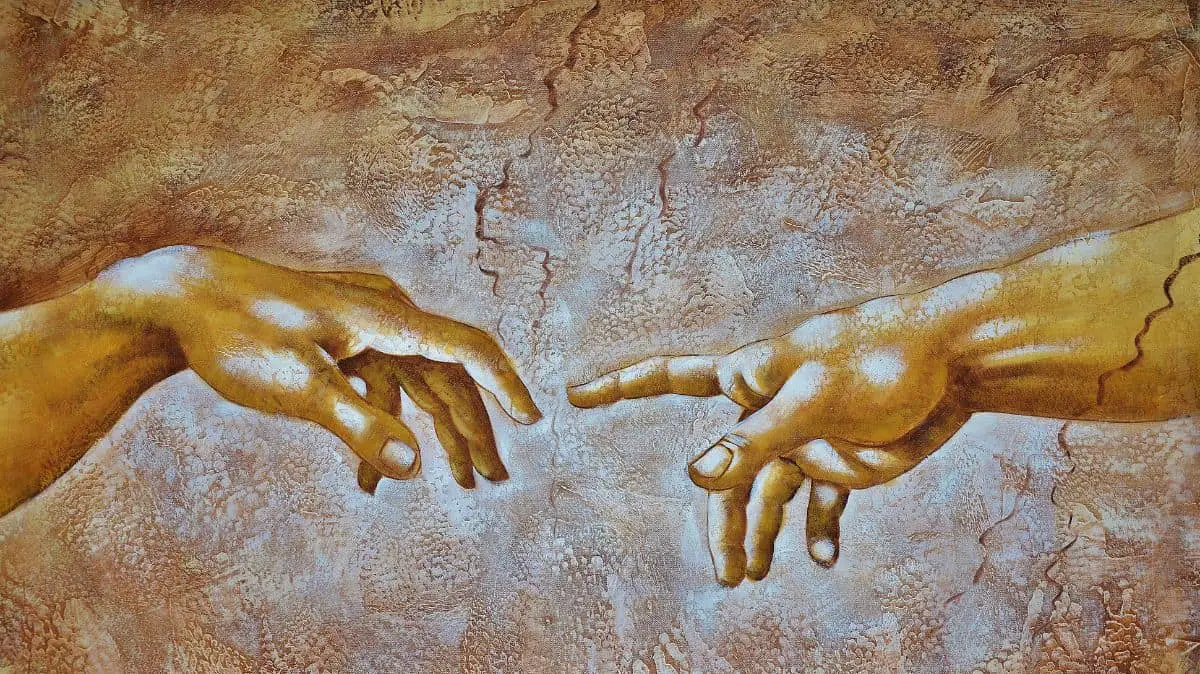
Writing an analysis of a picture can be a little daunting, especially if analyzing and essay writing are not your strengths. Not to worry. In this tutorial, you’ll learn how to do it, even if you’re a beginner.
To write an effective visual analysis, all you need to do is break the image into parts and discuss the relationship between them. That’s it in a nutshell.
Writing an image analysis essay, whether you’re analyzing a photo, painting, or any other kind of an image, is a simple, 6-step process. Let me take you through it.
Together, we’ll analyze a simple image and write a short analysis essay based on it. You can analyze any image, such as a photo or a painting, by following these steps.
Here is a simple image we’ll analyze.
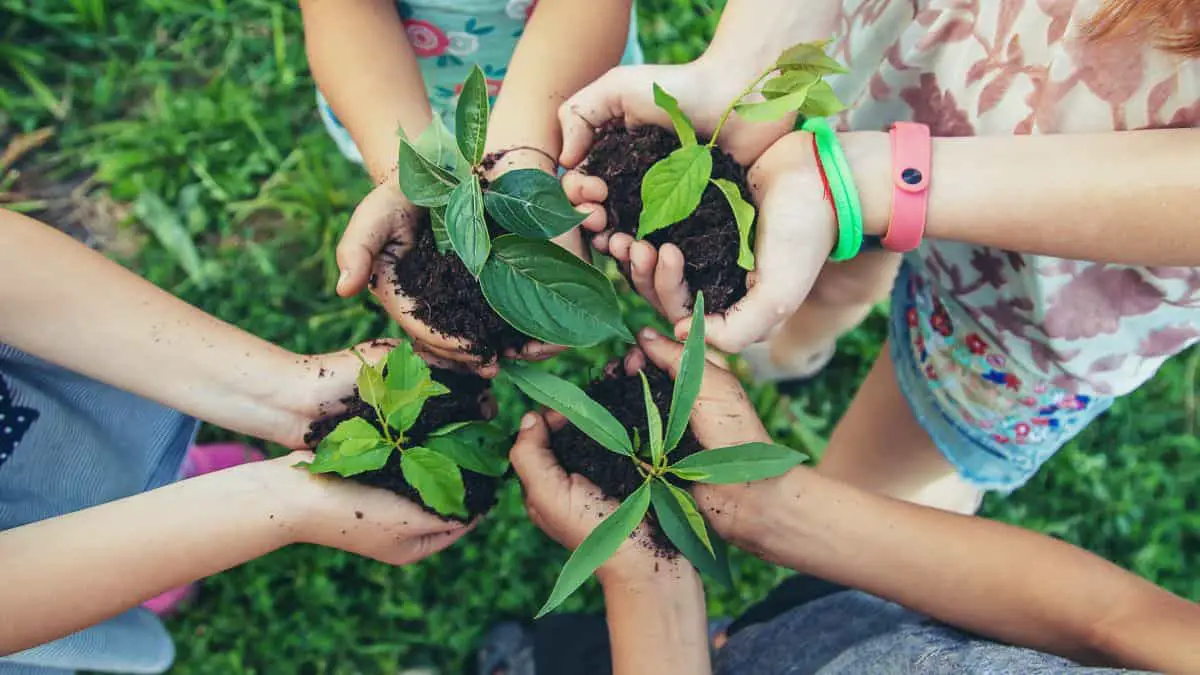
And we’re ready for the…
6 Steps to Writing a Visual Analysis Essay
Step 1: Identify the Elements
When you look at this image, what do you see?
Right now, you are not just a casual observer. You are like a detective who must inspect things thoroughly and be careful not to miss any details.
So, let’s put on our Sherlock Holmes hat, grab a magnifying glass, and make a list of all the major and some minor elements of this picture.
What do we observe?
- Children. How many? Four.
- Children’s hands. Four pairs.
Great. These are all human elements. In fact, it would be useful for us to have two categories of elements: human and non-human.
When we group elements into categories, it will help us later when we’ll be writing the essay. Categories make it easier to think about the elements.
What other elements do we see?
- The hands are holding soil.
- Each handful of soil also has a tiny plant in it.
- Finally, we see the green lawn or ground on which the children stand.
These are all of the obvious elements in the image. But can we dig deeper and observe more?
Again, wearing our Sherlock Holmes hat, our job is to gather information that may not be immediately obvious or noticeable.
Let’s take another look, using our detective tentacles:
- The children’s hands are arranged in a circle.
- The children’s skin color varies from lighter to darker.
- The children wear summer clothes.
You may have noticed these elements even when you first saw the image. In that case, great job!
It looks like we’ve covered all the elements. We’re ready to move on to the next step.
Step 2. Detect Symbols and Connections
What does Sherlock Holmes or any good detective do after basic observation? It is time to think and use our logic and imagination.
We will now look for symbols and any connections or relationships among the elements.
Identifying Symbols
- Children symbolize future and hope.
- Their hands form a circle, creating a unifying effect. The symbol is unity, and there is power in unity.
- Children’s hands hold soil, and soil symbolizes earth, perhaps planet Earth.
- The earth holds young plants which symbolize the environment and ecology.
- The young plants also symbolize youth and the future.
- The children wear summer clothes, and summer symbolizes happiness and freedom because this is when children are on vacation and enjoy life.
Great. Now, let’s see if we can make some connections and identify some relationships among the elements and symbols.
We will use our imagination to put together some kind of a meaning.
In analyzing an image, we want to understand what the creator or the artist is trying to convey.
Do artists and photographers always want to convey something or is it sometimes just a picture?
It doesn’t matter because we never know what the artist really thought when creating the work . We’re not mind readers.
But we can always gather meaning using our own logic and imagination. We can derive meaning from any image. And that’s all we need to do to write an analysis essay.
Finding Connections and Relationships
Let’s allow our imagination to roam free and write down a few thoughts. Some ideas will be more obvious than others.
- This entire image seems to be about the future of the environment.
- Why is this future important? It’s important because of the future generations, symbolized by the children.
- A strong sense of long-term future is conveyed because not only do the children hold plants, but these are baby plants. The message is “children hold future generations.”
- The variety of skin colors implies diversity. Also, the hands form a circle. Together, these two elements can mean: “global diversity.”
As you can see, we can derive really interesting meaning from even a simple image.
We did a great job here and now have plenty of material to work with and write about. It’s time for the next step.
Step 3. Formulate Your Thesis
In this step, your task is to put together an argument that you will support in your essay. What can this argument be?
The goal of writing a visual analysis is to arrive at the meaning of the image and to reveal it to the reader.
We just finished the analysis by breaking the image down into parts. As a result, we have a pretty good idea of the meaning of the image.
Now, we need to take these parts and put them together into a meaningful statement. This statement will be our thesis.
Let’s do it.
Writing the Thesis
This whole picture may mean something like the following:
This sounds good. Let’s write another version:
This sounds good, as well. What is the difference between the two statements?
The first one places the responsibility for the future of the planet on children.
The second one places this responsibility on the entire humanity.
Therefore, the second statement just makes more sense. Based on it, let’s write our thesis.
We now have our thesis, which means we know exactly what argument we will be supporting in the essay.
Step 4: Write the Complete Thesis Statement
While a thesis is our main point, a thesis statement is a complete paragraph that includes the supporting points.
To write it, we’ll use the Power of Three. This means that we are going to come up with three supporting points for our main point.
This is where our categories from Step 1 will come in handy. These categories are human and non-human elements. They will make up the first two supporting points for the thesis.
The third supporting point can be the relationships among the elements.
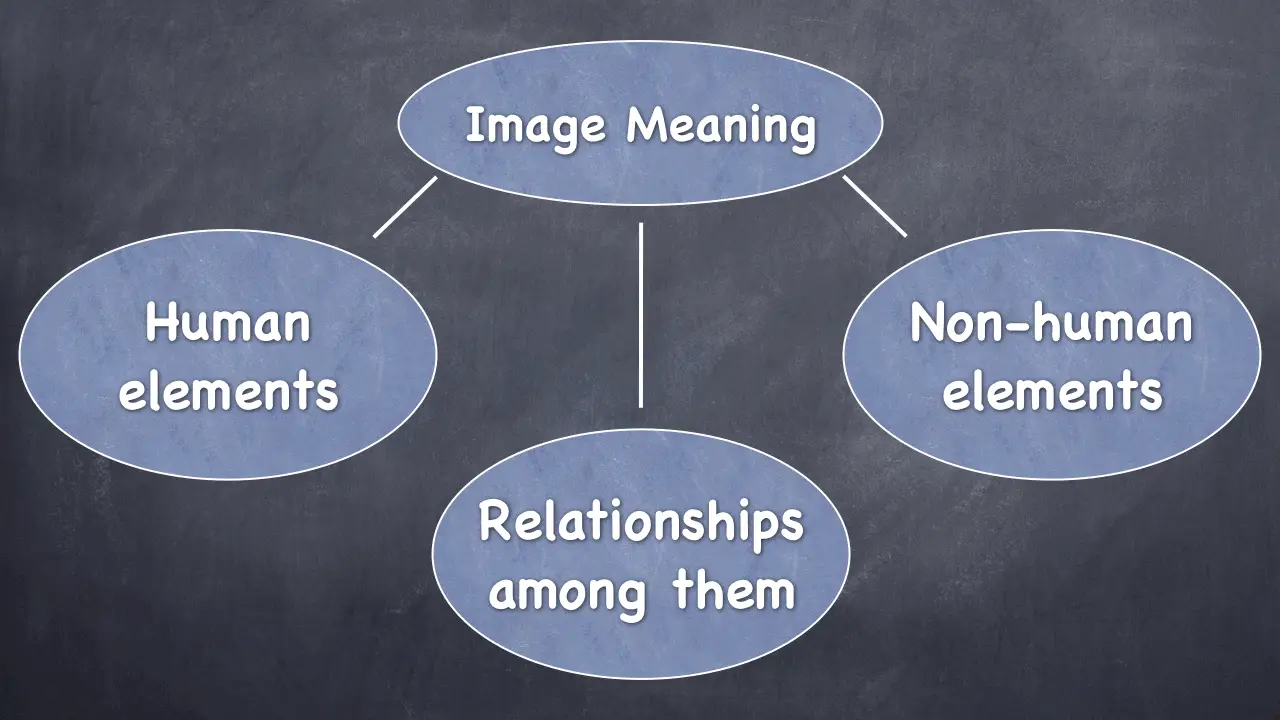
We can also pick a different set of supporting points. Our job here is to simply have three supporting ideas that make sense to us.
For example, we have our elements, symbols, and connections. And we can structure the complete argument this way:
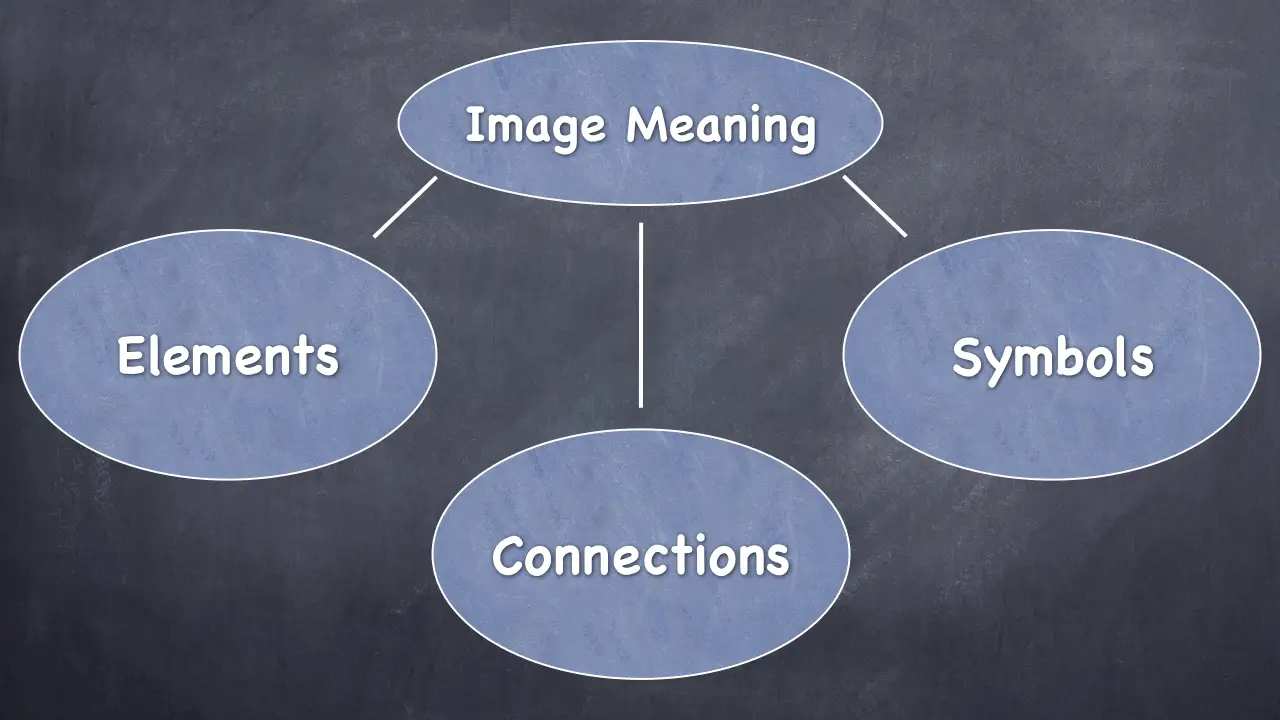
All we really need is one way to organize our thoughts in the essay. Let’s go with the first version and formulate the supporting points.
Here’s our main point again:
Here are our supporting points:
- The photographer uses the image of children to symbolize the future.
- The non-human elements in the photo symbolize life and planet Earth.
- The author connects many ideas represented by images to get the message across.
Now we have everything we need to write the complete thesis statement. We’ll just put the main and the supporting statements into one paragraph.
Thesis Statement
Step 5: write the body of your essay.
At this point, we have everything we need to write the rest of the essay. We know that it will have three main sections because the thesis statement is also our outline.
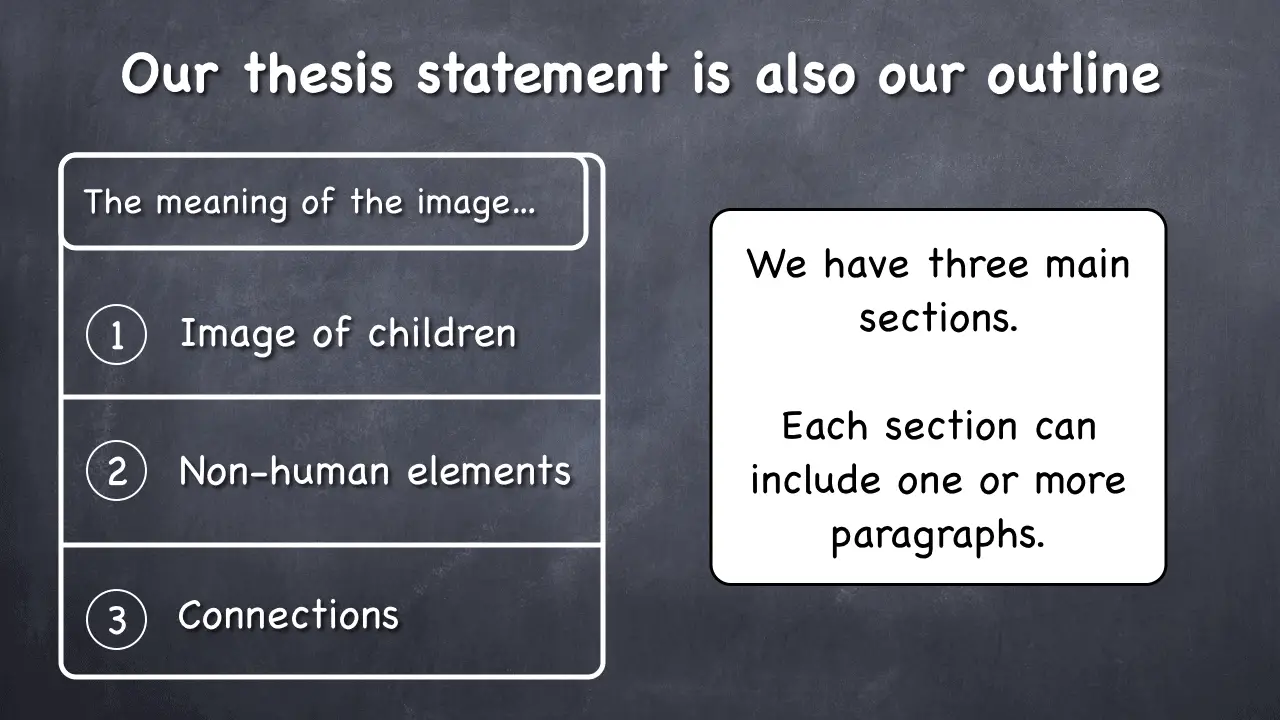
We’re ready to write the body of the essay. Let’s do it.

Body of the Essay (3 paragraphs)
“The author of this photograph chose children and, more specifically, children’s hands in order to convey his point. In many, if not all human cultures, children evoke the feelings of hope, new beginnings, and the future. This is why people often say, ‘Children are our future.’ Furthermore, the children in the photo are of different ethnic backgrounds. This is evident from their skin colors, which vary from lighter to darker. This detail shows that the author probably meant children all over the world.
The non-human elements of the picture are the plants and the soil. The plants are very young – they are just sprouts, and that signifies the fragility of life. The soil in which they grow evokes the image of our planet Earth. Soil also symbolizes fertility. The clothes the children wear are summer clothes, and summer signifies freedom because this is the time of a long vacation for school children. Perhaps the author implies that the environment affects people’s freedom.
Finally, the relationships and connections among these elements help the photographer convey the message that humans should be mindful of their decisions today to ensure a bright future for the planet. This idea can be arrived at by careful examination. First, the children’s hands are arranged in a circle, which is a symbol of our planet and also signifies the power of unity. The future depends on people’s cooperation. Second, the children seem to be in the process of planting. The author emphasizes long-term future because the children hold baby plants. In other words, they ‘hold the future of other children’ in their hands. Third, the placement of the sprouts, which rest inside the soil in children’s hands, is a strong way to suggest that the future of the ecology is literally ‘in our hands.’”
Step 6. Add an Introduction and a Conclusion
Before we continue, I have an entire detailed article on how to write an essay step-by-step for beginners . In it, I walk you through writing every part of an essay, from the thesis to the conclusion.
Introduction
That said, your introduction should be just a sentence or two that go right before you state the thesis.
Let’s revisit our thesis statement, and then write the introduction.
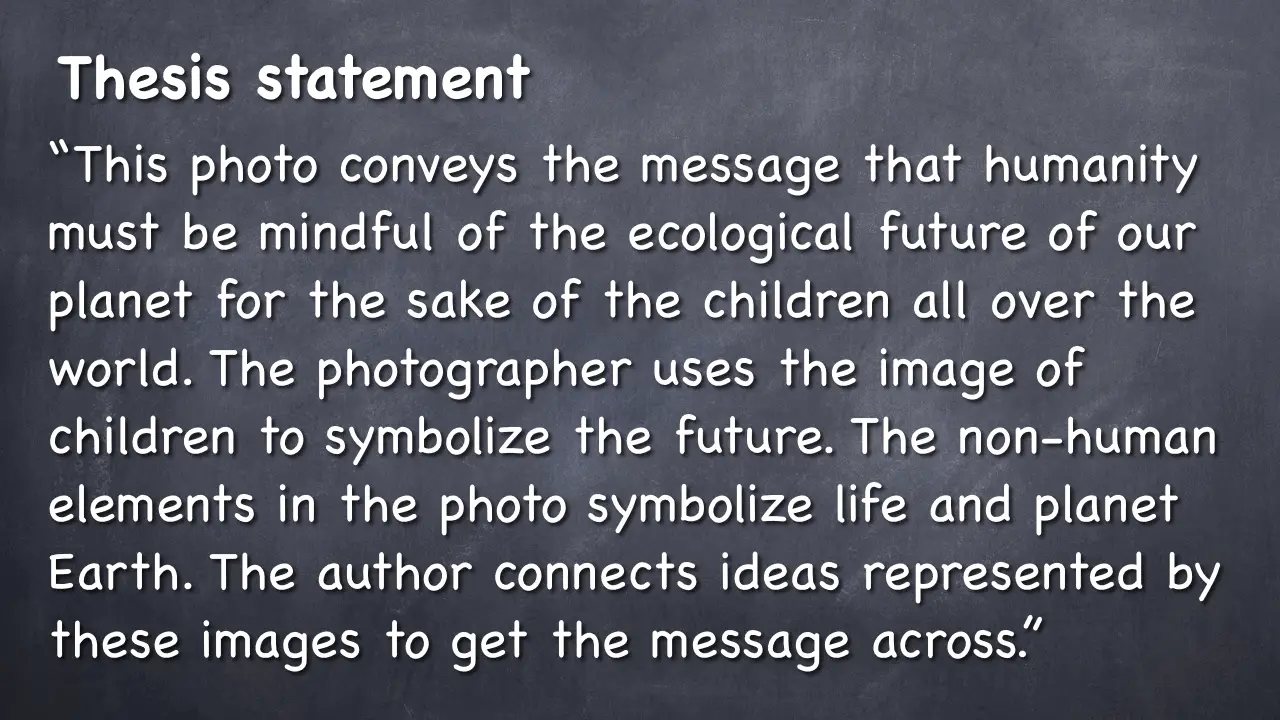
And now let’s write an introductory sentence that would make the opening paragraph complete:
Now, if you read this intro sentence followed by the thesis statement, you’ll see that they work great together. And we’re done with the opening paragraph.
Your conclusion should be just a simple restatement. You can conclude your essay in many ways, but this is the basic and time-proven one.
Let’s do it:
We simply restated our thesis here. Your conclusion can be one or more sentences. In a short essay, a sentence will suffice.
Guess what – we just wrote a visual analysis essay together, and now you have a pretty good idea of how to write one.
Hope this was helpful!
How to Write a 300 Word Essay – Simple Tutorial
How to expand an essay – 4 tips to increase the word count, 10 solid essay writing tips to help you improve quickly, essay writing for beginners: 6-step guide with examples, 6 simple ways to improve sentence structure in your essays.
Tutor Phil is an e-learning professional who helps adult learners finish their degrees by teaching them academic writing skills.
You Might Like These Next...
How to Write a Summary of an Article in 5 Easy Steps
https://youtu.be/mXGNf8JMY4Y When you’re summarizing, you’re simply trying to express something in fewer words. I’m Tutor Phil, and in this tutorial, I’ll show you how to summarize an...
How to Write Strong Body Paragraphs in an Essay
https://youtu.be/OcI9NKg_cEk A body paragraph in an essay consists of three parts: topic sentence, explanation, and one or more examples. The topic sentence summarizes your paragraph completely...

Extended Essay Resources: Finding and Citing Images
- Research Video Tutorials
- Video Tutorials
- In-text Citations
- Finding and Citing Images
- Plagiarism VS. Documentation
- MiniLessons
- Human Rights News
- Peace & Conflict News
- Primary Sources
- Introductory Resources
- Narrowing Your Topic
- Subject Resources
Using Images in a Presentation
Is the image for decoration? If yes, follow below. No? Keep scrolling.
1. Royalty-free clipart does not require an attribution.
2. Public domain images don't require an attribution. However, it's considered good form to allow your audience to find your images. You should make an attribution in a caption beneath or adjacent to the image that states the title/name of the image, the author/creator (if you can find it), the source, and the license. Then h yperlink the title of the image and author to the source of the image. See the box below for more information on creating attributions. For example:

Lightbulb by ColiN00B is licensed under Creative Commons CC0
Photo by ColiN00B on Pixabay
Is the image for analysis or to support your argument? If yes, follow below.
1. In this case, you are using the image in an academic way so you should provide an MLA citation. Remember, a URL is not a citation. You must provide a citation for an image in the same way that you make a citation for a book or a website. Use NoodleTools to help. You can list citations like this:
Creator’s Last name, First name. “Title of the digital image.” Title of the website , First name Last name of any contributors, Version (if applicable), Number (if applicable), Publisher, Publication date, URL.
Vasquez, Gary A. Photograph of Coach K with Team USA. NBC Olympics , USA Today Sports, 5 Aug. 2016, www.nbcolympics.com/news/rio-olympics-coach-ks-toughest-test-or-lasting-legacy.
2. You can put the citation as a caption beneath the image. You can also list it with your other references in your "Works Cited" list.
Creative Commons and Royalty-Free Media
- 10 Websites with Free Stock Video Footage Free royalty free stock footage is hard to find but we have compiled a list of some of the better sites that are offering a selection of video clips available for download and use in personal and commercial projects.
- Compfight Locate the visual inspiration you need. Super fast!
- Creative Commons Search for images and videos with a Creative Commons re-use license on multiple websites.
- Flickr Commons Images with no known copyright restrictions from various cultural heritage institutions
- Getty Search Gateway The Getty Search Gateway allows users to search across several of the Getty repositories, including collections databases, library catalogs, collection inventories, and archival finding aids.
- Google Images Choose "Tools" > Choose "Usage Rights" > Choose "Labeled for reuse"
- Morguefile Morguefile is a free photo archive “for creatives, by creatives.”
- Open Clipart Free, public domain clip art.
- Pexels.com Pexels provides high quality and completely free stock photos licensed under the Creative Commons Zero (CC0) license.
- Photos for Class Search now to download properly attributed, Creative Commons photos for school!
- Pixabay Pixabay is a vibrant community of creatives, sharing copyright free images and videos. All contents are released under Creative Commons CC0, which makes them safe to use without asking for permission or giving credit to the artist - even for commercial purposes.
- Snappygoat.com Over 13,000,000 free public domain images.
- Tineye Have an image but not sure where it's from? Try this reverse image search.
- Unsplash Over 1,000,000 free (do-whatever-you-want) high-resolution photos brought to you by the world’s most generous community of photographers.
- Video Assets from Camtasia Royalty-free elements to enhance your videos in Camtasia
- Wikimedia Commons Over 40 million freely usable media files. Attributions provided. This is a great source for finding historical images, as well.
How to make attributions next to an image
- Creative Commons - Best practices for attribution You can use CC-licensed materials as long as you follow the license conditions. One condition of all CC licenses is attribution. Here are some good (and not so good) examples of attribution.
If you use images, such as photographs or clipart , in your presentation, you should also credit the source of the image. Do not reproduce images without permission. See the box "Finding Public Domain Images" in this guide to find sources for images that are "public use".
Use the acronym TASL to remember how to attribute images:
T - Title/Description
A - Author or creator
S - Source & date (Name of the website the image is from)
L - License or location (Creative Commons license or URL)
For example...
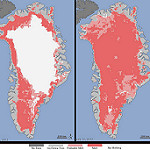
" Satellites See Unprecedented Greenland Ice Sheet Surface Melt " by NASA Goddard Space Flight Center is licensed under CC by 2.0
Title: Satellites See Unprecedented Greenland Ice Sheet Surface Melt Author: NASA Goddard Space Flight Center Source: Flickr (linked in title) License: CC by 2.0
Quick Guide
Citing images in mla.
- OWL Purdue - Images
- OWL Purdue - Tables and Figures The purpose of visual materials or other illustrations is to enhance the audience's understanding of information in the document and/or awareness of a topic. Writers can embed several types of visuals using most basic word processing software: diagrams, musical scores, photographs, or, for documents that will be read electronically, audio/video applications.
- OWL Purdue - Other types of sources Several sources have multiple means for citation, especially those that appear in varied formats: films, DVDs, T.V shows, music, published and unpublished interviews, interviews over e-mail; published and unpublished conference proceedings.
Public Domain Images
These images are in the public domain. They are free to use, but you must make an attribution or citation.
- << Previous: In-text Citations
- Next: Plagiarism VS. Documentation >>
- Last Updated: Aug 15, 2023 3:34 PM
- URL: https://libguides.aisr.org/extendedessay
The leading authority in photography and camera gear.
Become a better photographer.
12.9 Million
Annual Readers
Newsletter Subscribers
Featured Photographers
Photography Guides & Gear Reviews

How to Create an Engaging Photo Essay (with Examples)
Photo essays tell a story in pictures. They're a great way to improve at photography and story-telling skills at once. Learn how to do create a great one.
Learn | Photography Guides | By Ana Mireles
Photography is a medium used to tell stories – sometimes they are told in one picture, sometimes you need a whole series. Those series can be photo essays.
If you’ve never done a photo essay before, or you’re simply struggling to find your next project, this article will be of help. I’ll be showing you what a photo essay is and how to go about doing one.
You’ll also find plenty of photo essay ideas and some famous photo essay examples from recent times that will serve you as inspiration.
If you’re ready to get started, let’s jump right in!
Table of Contents
What is a Photo Essay?
A photo essay is a series of images that share an overarching theme as well as a visual and technical coherence to tell a story. Some people refer to a photo essay as a photo series or a photo story – this often happens in photography competitions.
Photographic history is full of famous photo essays. Think about The Great Depression by Dorothea Lange, Like Brother Like Sister by Wolfgang Tillmans, Gandhi’s funeral by Henri Cartier Bresson, amongst others.
What are the types of photo essay?
Despite popular belief, the type of photo essay doesn’t depend on the type of photography that you do – in other words, journalism, documentary, fine art, or any other photographic genre is not a type of photo essay.
Instead, there are two main types of photo essays: narrative and thematic .
As you have probably already guessed, the thematic one presents images pulled together by a topic – for example, global warming. The images can be about animals and nature as well as natural disasters devastating cities. They can happen all over the world or in the same location, and they can be captured in different moments in time – there’s a lot of flexibility.
A narrative photo essa y, on the other hand, tells the story of a character (human or not), portraying a place or an event. For example, a narrative photo essay on coffee would document the process from the planting and harvesting – to the roasting and grinding until it reaches your morning cup.
What are some of the key elements of a photo essay?
- Tell a unique story – A unique story doesn’t mean that you have to photograph something that nobody has done before – that would be almost impossible! It means that you should consider what you’re bringing to the table on a particular topic.
- Put yourself into the work – One of the best ways to make a compelling photo essay is by adding your point of view, which can only be done with your life experiences and the way you see the world.
- Add depth to the concept – The best photo essays are the ones that go past the obvious and dig deeper in the story, going behind the scenes, or examining a day in the life of the subject matter – that’s what pulls in the spectator.
- Nail the technique – Even if the concept and the story are the most important part of a photo essay, it won’t have the same success if it’s poorly executed.
- Build a structure – A photo essay is about telling a thought-provoking story – so, think about it in a narrative way. Which images are going to introduce the topic? Which ones represent a climax? How is it going to end – how do you want the viewer to feel after seeing your photo series?
- Make strong choices – If you really want to convey an emotion and a unique point of view, you’re going to need to make some hard decisions. Which light are you using? Which lens? How many images will there be in the series? etc., and most importantly for a great photo essay is the why behind those choices.
9 Tips for Creating a Photo Essay

Credit: Laura James
1. Choose something you know
To make a good photo essay, you don’t need to travel to an exotic location or document a civil war – I mean, it’s great if you can, but you can start close to home.
Depending on the type of photography you do and the topic you’re looking for in your photographic essay, you can photograph a local event or visit an abandoned building outside your town.
It will be much easier for you to find a unique perspective and tell a better story if you’re already familiar with the subject. Also, consider that you might have to return a few times to the same location to get all the photos you need.
2. Follow your passion
Most photo essays take dedication and passion. If you choose a subject that might be easy, but you’re not really into it – the results won’t be as exciting. Taking photos will always be easier and more fun if you’re covering something you’re passionate about.
3. Take your time
A great photo essay is not done in a few hours. You need to put in the time to research it, conceptualizing it, editing, etc. That’s why I previously recommended following your passion because it takes a lot of dedication, and if you’re not passionate about it – it’s difficult to push through.
4. Write a summary or statement
Photo essays are always accompanied by some text. You can do this in the form of an introduction, write captions for each photo or write it as a conclusion. That’s up to you and how you want to present the work.
5. Learn from the masters
How Much Do You REALLY Know About Photography?! 🤔
Test your photography knowledge with this quick quiz!
See how much you really know about photography...

Your answer:
Correct answer:
SHARE YOUR RESULTS
Your Answers
Making a photographic essay takes a lot of practice and knowledge. A great way to become a better photographer and improve your storytelling skills is by studying the work of others. You can go to art shows, review books and magazines and look at the winners in photo contests – most of the time, there’s a category for photo series.
6. Get a wide variety of photos
Think about a story – a literary one. It usually tells you where the story is happening, who is the main character, and it gives you a few details to make you engage with it, right?
The same thing happens with a visual story in a photo essay – you can do some wide-angle shots to establish the scenes and some close-ups to show the details. Make a shot list to ensure you cover all the different angles.
Some of your pictures should guide the viewer in, while others are more climatic and regard the experience they are taking out of your photos.
7. Follow a consistent look
Both in style and aesthetics, all the images in your series need to be coherent. You can achieve this in different ways, from the choice of lighting, the mood, the post-processing, etc.
8. Be self-critical
Once you have all the photos, make sure you edit them with a good dose of self-criticism. Not all the pictures that you took belong in the photo essay. Choose only the best ones and make sure they tell the full story.
9. Ask for constructive feedback
Often, when we’re working on a photo essay project for a long time, everything makes perfect sense in our heads. However, someone outside the project might not be getting the idea. It’s important that you get honest and constructive criticism to improve your photography.
How to Create a Photo Essay in 5 Steps

Credit: Quang Nguyen Vinh
1. Choose your topic
This is the first step that you need to take to decide if your photo essay is going to be narrative or thematic. Then, choose what is it going to be about?
Ideally, it should be something that you’re interested in, that you have something to say about it, and it can connect with other people.
2. Research your topic
To tell a good story about something, you need to be familiar with that something. This is especially true when you want to go deeper and make a compelling photo essay. Day in the life photo essays are a popular choice, since often, these can be performed with friends and family, whom you already should know well.
3. Plan your photoshoot
Depending on what you’re photographing, this step can be very different from one project to the next. For a fine art project, you might need to find a location, props, models, a shot list, etc., while a documentary photo essay is about planning the best time to do the photos, what gear to bring with you, finding a local guide, etc.
Every photo essay will need different planning, so before taking pictures, put in the required time to get things right.
4. Experiment
It’s one thing to plan your photo shoot and having a shot list that you have to get, or else the photo essay won’t be complete. It’s another thing to miss out on some amazing photo opportunities that you couldn’t foresee.
So, be prepared but also stay open-minded and experiment with different settings, different perspectives, etc.
5. Make a final selection
Editing your work can be one of the hardest parts of doing a photo essay. Sometimes we can be overly critical, and others, we get attached to bad photos because we put a lot of effort into them or we had a great time doing them.
Try to be as objective as possible, don’t be afraid to ask for opinions and make various revisions before settling down on a final cut.
7 Photo Essay Topics, Ideas & Examples

Credit: Michelle Leman
- Architectural photo essay
Using architecture as your main subject, there are tons of photo essay ideas that you can do. For some inspiration, you can check out the work of Francisco Marin – who was trained as an architect and then turned to photography to “explore a different way to perceive things”.
You can also lookup Luisa Lambri. Amongst her series, you’ll find many photo essay examples in which architecture is the subject she uses to explore the relationship between photography and space.
- Process and transformation photo essay
This is one of the best photo essay topics for beginners because the story tells itself. Pick something that has a beginning and an end, for example, pregnancy, the metamorphosis of a butterfly, the life-cycle of a plant, etc.
Keep in mind that these topics are linear and give you an easy way into the narrative flow – however, it might be difficult to find an interesting perspective and a unique point of view.
- A day in the life of ‘X’ photo essay
There are tons of interesting photo essay ideas in this category – you can follow around a celebrity, a worker, your child, etc. You don’t even have to do it about a human subject – think about doing a photo essay about a day in the life of a racing horse, for example – find something that’s interesting for you.
- Time passing by photo essay
It can be a natural site or a landmark photo essay – whatever is close to you will work best as you’ll need to come back multiple times to capture time passing by. For example, how this place changes throughout the seasons or maybe even over the years.
A fun option if you live with family is to document a birthday party each year, seeing how the subject changes over time. This can be combined with a transformation essay or sorts, documenting the changes in interpersonal relationships over time.
- Travel photo essay
Do you want to make the jump from tourist snapshots into a travel photo essay? Research the place you’re going to be travelling to. Then, choose a topic.
If you’re having trouble with how to do this, check out any travel magazine – National Geographic, for example. They won’t do a generic article about Texas – they do an article about the beach life on the Texas Gulf Coast and another one about the diverse flavors of Texas.
The more specific you get, the deeper you can go with the story.
- Socio-political issues photo essay
This is one of the most popular photo essay examples – it falls under the category of photojournalism or documental photography. They are usually thematic, although it’s also possible to do a narrative one.
Depending on your topic of interest, you can choose topics that involve nature – for example, document the effects of global warming. Another idea is to photograph protests or make an education photo essay.
It doesn’t have to be a big global issue; you can choose something specific to your community – are there too many stray dogs? Make a photo essay about a local animal shelter. The topics are endless.
- Behind the scenes photo essay
A behind-the-scenes always make for a good photo story – people are curious to know what happens and how everything comes together before a show.
Depending on your own interests, this can be a photo essay about a fashion show, a theatre play, a concert, and so on. You’ll probably need to get some permissions, though, not only to shoot but also to showcase or publish those images.
4 Best Photo Essays in Recent times
Now that you know all the techniques about it, it might be helpful to look at some photo essay examples to see how you can put the concept into practice. Here are some famous photo essays from recent times to give you some inspiration.
Habibi by Antonio Faccilongo
This photo essay wan the World Press Photo Story of the Year in 2021. Faccilongo explores a very big conflict from a very specific and intimate point of view – how the Israeli-Palestinian war affects the families.
He chose to use a square format because it allows him to give order to things and eliminate unnecessary elements in his pictures.
With this long-term photo essay, he wanted to highlight the sense of absence and melancholy women and families feel towards their husbands away at war.
The project then became a book edited by Sarah Leen and the graphics of Ramon Pez.

Picture This: New Orleans by Mary Ellen Mark
The last assignment before her passing, Mary Ellen Mark travelled to New Orleans to register the city after a decade after Hurricane Katrina.
The images of the project “bring to life the rebirth and resilience of the people at the heart of this tale”, – says CNNMoney, commissioner of the work.
Each survivor of the hurricane has a story, and Mary Ellen Mark was there to record it. Some of them have heartbreaking stories about everything they had to leave behind.
Others have a story of hope – like Sam and Ben, two eight-year-olds born from frozen embryos kept in a hospital that lost power supply during the hurricane, yet they managed to survive.

Selfie by Cindy Sherman
Cindy Sherman is an American photographer whose work is mainly done through self-portraits. With them, she explores the concept of identity, gender stereotypes, as well as visual and cultural codes.
One of her latest photo essays was a collaboration with W Magazine entitled Selfie. In it, the author explores the concept of planned candid photos (‘plandid’).
The work was made for Instagram, as the platform is well known for the conflict between the ‘real self’ and the one people present online. Sherman started using Facetune, Perfect365 and YouCam to alter her appearance on selfies – in Photoshop, you can modify everything, but these apps were designed specifically to “make things prettier”- she says, and that’s what she wants to explore in this photo essay.
Tokyo Compression by Michael Wolf
Michael Wolf has an interest in the broad-gauge topic Life in Cities. From there, many photo essays have been derived – amongst them – Tokyo Compression .
He was horrified by the way people in Tokyo are forced to move to the suburbs because of the high prices of the city. Therefore, they are required to make long commutes facing 1,5 hours of train to start their 8+ hour workday followed by another 1,5 hours to get back home.
To portray this way of life, he photographed the people inside the train pressed against the windows looking exhausted, angry or simply absent due to this way of life.
You can visit his website to see other photo essays that revolve around the topic of life in megacities.
Final Words
It’s not easy to make photo essays, so don’t expect to be great at it right from your first project.
Start off small by choosing a specific subject that’s interesting to you – that will come from an honest place, and it will be a great practice for some bigger projects along the line.
Whether you like to shoot still life or you’re a travel photographer, I hope these photo essay tips and photo essay examples can help you get started and grow in your photography.
Let us know which topics you are working on right now – we’ll love to hear from you!

Check out these 8 essential tools to help you succeed as a professional photographer.
Includes limited-time discounts.
You'll Also Like These:

Ana Mireles is a Mexican researcher that specializes in photography and communications for the arts and culture sector.
Penelope G. To Ana Mireles Such a well written and helpful article for an writer who wants to inclue photo essay in her memoir. Thank you. I will get to work on this new skill. Penelope G.
Herman Krieger Photo essays in black and white
Leave a Comment Cancel Reply
👋 WELCOME TO SHOTKIT!

🔥 Popular NOW:

Unlock the EXACT blueprint to capture breathtaking iPhone photos!
Shotkit may earn a commission on affiliate links. Learn more.
- Subject guides
- Citing and referencing
- Images / Figures
Citing and referencing: Images / Figures
- In-text citations
- Reference list
- Books and book chapters
- Journals/Periodicals
- Newspapers/Magazines
- Government and other reports
- Legal sources
- Websites and social media
- Audio, music and visual media
- Conferences
- Dictionaries/Encyclopedias/Guides
- Theses/Dissertations
- University course materials
- Company and Industry reports
- Patents and Standards
- Tables and Figures
- Abbreviations used in referencing
- Medicine and Health sources
- Foreign language sources
- Music scores
- Journals and periodicals
- Government sources
- News sources
- Web and social media
- Games and apps
- Ancient and sacred sources
- Primary sources
- Audiovisual media and music scores
- Images and captions
- University lectures, theses and dissertations
- Interviews and personal communication
- Archival material
- In-Text Citations: Further Information
- Reference List: Standard Abbreviations
- Data Sheets (inc. Material Safety Data Sheets (MSDS))
- Figures & Tables (inc. Images)
- Lecture Materials (inc. PowerPoint Presentations)
- Reports & Technical Reports
- Theses and Dissertations
- Reference list guidelines
- Journal articles
- Government and industry publications
- Websites, newspaper and social media
- Conference papers, theses and university material
- Video and audio
- Images, graphs, tables, data sets
- Personal communications
- In-text Citations
- Journals / Periodicals
- Encyclopedias and Dictionaries
- Interviews and lectures
- Music Scores / Recordings
- Film / Video Recording
- Television / Radio Broadcast
- Online Communication / Social Media
- Live Performances
- Government and Organisation Publications
- Medicine & health sources
- Government/organisational/technical reports
- Images, graphs, tables, figures & data sets
- Websites newspaper & magazine articles, socia media
- Conferences, theses & university materials
- Personal communication & confidential unpublished material
- Video, audio & other media
- Generative AI
- Indigenous knowledges
Turabian Contents
- Introduction to Turabian Style
- Websites / Blogs
- Audiovisual
- Exhibitions
- Magazines / Newspapers
- Citing a source within a source
- University course materials / Theses / Exegeses
Rules for images
1. If you include any images in your document, also include a figure caption. See the "Positioning images in your document" box for more information.
2. If you refer to any visual material, i.e. art, design or architecture, you have seen in person and you are not including an image of it in your document, provide a detailed in-text citation or footnote. See the "Art, design and architecture you have seen in person" box for more information.
3. If you have sourced an image from the web or a publication:
a) Notes Bibliography style: you need to include the publication information or web address in the footnote. See the "Images from the web" or "Images from books or other published sources" for more information.
b) Author Date style: you need to include a brief in-text citation AND a full bibliography entry. See the "Images from the web" or "Images from books or other published sources" for more information.
Positioning images in your document
- Author-Date (Parenthetical citations)
Positioning images in your document
Figures are any images that you include in your document, i.e. illustrations, diagrams, graphs, photographs, images of artworks and etc. Whenever you include a figure in your document, you also provide a caption. Captions give concise descriptions, explanations, legends, or identify elements—depending on the type of figure. Position a caption below each figure.
Begin each caption with a figure number. And in your text, refer to the particular figure as you introduce it, spell out the word 'figure' if its in your sentence, or abbreviate to 'fig.' if it's written in parenthesis i.e. "in figure 1 you can see..." or (see fig. 1).
You may be the author of a figure in your document or you may have sourced it from elsewhere. If figures aren’t your work, captions can provide reference information, i.e. authors, titles and sources. Some assessments may require you to include a courtesy line acknowledging the name of the source organisation, archive or database, followed by an access date and the web address.
Example: In his painting The Banquet of Cleopatra (see fig. 1), Venetian artist Giambattista Tiepolo portrays a famous contest where Cleopatra wins a wager with Mark Antony by dissolving a pearl earring in a glass of vinegar and drinking it. Tiepolo stage this scene amid columns of the composite order (see fig. 2), which visually underline links to ancient Rome (see fig. 3).
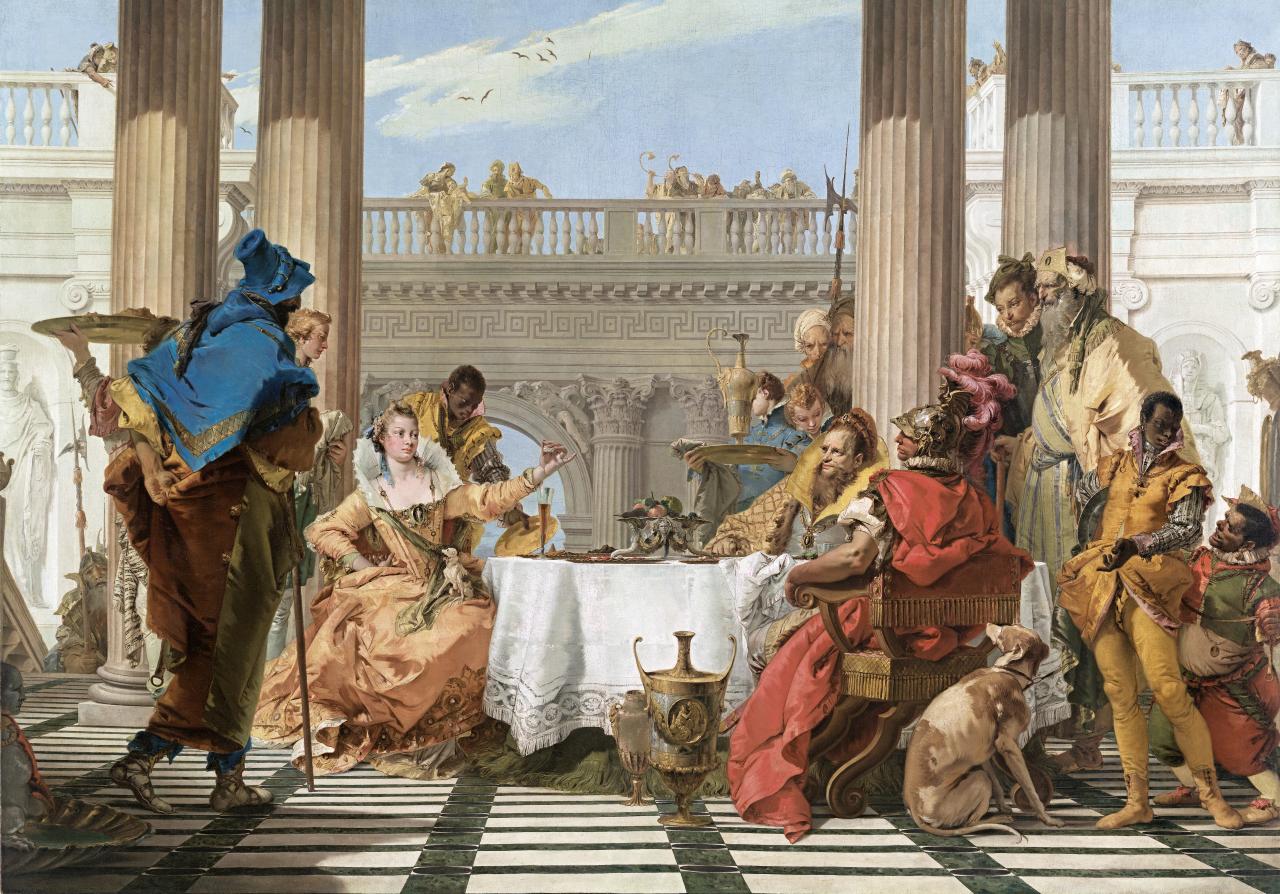
Figure 1. Giambattista Tiepolo, The Banquet of Cleopatra , 1743-44, oil on canvas, 250 x 357 cm. Courtesy of the National Gallery of Victoria, accessed 12 March, 2020, https://www.ngv.vic.gov.au/explore/collection/work/4409/.

Figure 2. The composite order, showing a , the entablature and b , the column capital. Courtesy of OpenClipart-Vectors from Pixabay, accessed 12 March, 2020, https://pixabay.com/vectors/column-capital-composite-antiquity-148231/.
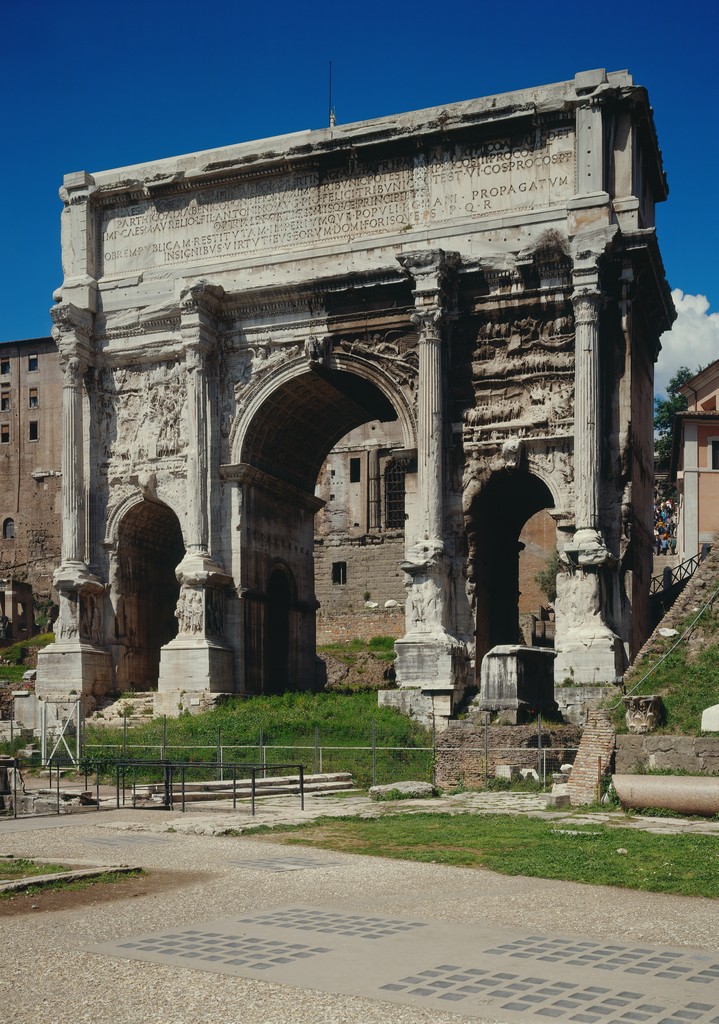
Figure 3. The Arch of Septimius Severus, 203 ce., Roman Forum, Rome. Courtesy of Artstor, accessed 12 March, 2020, https://library-artstor-org.ezproxy.lib.monash.edu.au.
Example: In his painting The Banquet of Cleopatra (see fig. 1), Venetian artist Giambattista Tiepolo portrays a famous contest where Cleopatra wins a wager with Mark Antony by dissolving a pearl earring in a glass of vinegar and drinking it. Tiepolo stage this scene amid columns of the composite order (see fig. 2), which visually underline links to ancient Rome (see fig. 3).
Figure 2. The composite order, showing a , the entablature and b , the column capital. Courtesy of OpenClipart-Vectors from Pixabay, accessed 12 March, 2020, https://pixabay.com/vectors/column-capital-composite-antiquity-148231/.
Figure 3. The Arch of Septimius Severus, 203 ce., Roman Forum, Rome. Courtesy of Artstor, accessed 12 March, 2020, https://library-artstor-org.ezproxy.lib.monash.edu.au.
Art, design and architecture you have seen in person
If you are referring to art, design or architecture and you are not including the image in your document, you only need to provide a detailed footnote.
Include the following information:
- artist or designer
- title of the work
- year of creation of work
- type of materials (optional)
- dimensions of the work (optional)
- location of item, e.g. name of the institution that houses the work, or city the building is in
Footnote 1. Giambattista Tiepolo, The Banquet of Cleopatra , 1743-44, oil on canvas, 250.3 x 357.0 cm, National Gallery of Victoria, Melbourne.
If you are referring to the actual artwork and you are not including the image in your document, you only need to provide a detailed in text citation.
- location of item, e.g. name institution that houses the work, or city the building is in
Parenthetical (In Text) (Georgia O'Keeffe, The Cliff Chimneys , 1938, Milwaukee Art Museum, Wisconsin )
Images from the web
- Author-Date (Parenthetical citations)
If you found the image online you will need to include in your footnote:
- title of work
- access date
1. Giambattista Tiepolo, The Banquet of Cleopatra , 1743-44, oil on canvas, 250.3 x 357.0 cm, accessed 24 May, 2012, http://www.ngv.vic.gov.au/col/work/4409 .
2. Max Dupain, The Sunbaker , 1937, gelatin silver photograph, 38.0 x 43.1 cm, accessed 24 May, 2012 , http://www.ngv.vic.gov.au/col/work/7621 .
If you found the image online you need to include a brief parenthetical (in text) citation and a bibliography entry that includes:
Examples:
Parenthetical (In Text)
(Tiepolo 1743-44)
(Dupain 1937)
Bibliography
Tiepolo, Giambattista. 1743-44. The Banquet of Cleopatra. Oil on canvas. A ccessed 24 May, 2012. http://www.ngv.vic.gov.au/col/work/4409 .
Dupain, Max. 1937. The Sunbaker . Photograph. A ccessed 24 May, 2012. http://www.ngv.vic.gov.au/col/work/7621 .
Images from books or other published sources
If you found the image in a book or other published source you will need to include in the footnote:
- date of creation of work
- author of book
- title of book
- place of publication
- date of publication
- figure or plate number of the reproduction (optional)
1. Giambattista Tiepolo, The Banquet of Cleopatra , 1743-44, in Ted Gott and Laurie Benson, Painting and Sculpture before 1800 in the International Collections of the National Gallery of Victoria (Melbourne: National Gallery of Victoria, 2003), 102.
2. Max Dupain, "The Sunbaker", 1937, in Isobel Crombie, Body Culture: Max Dupain, Photography and Australian Culture 1919-1939 (Images Publishing Group in association with National Gallery of Victoria, 2004), 150, 17.1.
If you found the image in a book or other published source you will need to include an in text citation as well as a bibliography entry that includes:
(Georgia O'Keeffe, The Cliff Chimneys , 1938, in Lynes, Poling-Kempes, and Turner 2004, 25)
Lynes, Barbara Buhler, Lesley Poling-Kempes, and Frederick W. Turner. 2004. Georgia O'Keeffe and New Mexico: A sense of place . Princeton, NJ: Princeton University Press.
- Do Not Sell My Personal Info

- ⋅
- Content Creation
The Essential Guide To Using Images Legally Online
Are you using images legally online? Learn how to avoid copyright infringement and protect yourself from legal consequences with this guide.

The information in this article is not intended to and does not constitute legal advice. Only your attorney or your organization’s counsel can provide assurances that the information contained herein – and your interpretation of it – is applicable or appropriate to your particular situation.
Images are an essential component of online content – and it’s obvious why. Images aren’t just pretty—they’re powerful marketing tools that help you stand out.
They pique your audience’s attention, enhance your messaging, and significantly enhance the appeal and effectiveness of your content.
Whether you’re creating a social media post, a webpage, an ebook, a blog post, or something else, adding visuals goes a long way in improving the overall user experience.
However, you can’t just pull images off the internet and use them – and it’s your responsibility to determine if and how you can use the image without breaking the law.
If you violate copyright law – even accidentally – you can face serious consequences. Many online platforms, such as Google and YouTube , have copyright policies that streamline copyright claims and enforcement actions. Often, a minor violation will result in receiving a DMCA notice and the content being removed or demonetized. However, if a violation is egregious or impactful enough, you could face heavier consequences such as hefty fines, court trials, and, in extreme cases, even jail time.
In this article, we’ll explore how you can navigate these murky waters to ensure that you’re using images impactfully and legally online.
What Is Copyright Law?
Copyright law is complex and dynamic, and it requires a careful approach to using images online – especially in the wake of tech advancements like generative AI .
Every image – whether you find it on Google, social media, or a stock photo site – gains copyright as soon as it’s created, and it’s up to you to discern whether or not you have the legal right to use it.
Copyright is designed to protect the creative works of authors, photographers, artists, and other creators. It gives them the exclusive rights to use, distribute, and modify their creations.
Without such laws, creators would have few defenses against individuals and corporations alike simply stealing their work and using it for whatever purposes they desire.
And while the foundational principle of copyright remains unchanged, the landscape around these laws is always evolving.
A recent example of this is the CASE Act of 2020 , which created a small claims solution to make it easier for creatives to make copyright complaints without the need for long, expensive legal battles.
This goes to show how important it is to understand and respect copyright law, as its goal is to balance the interests of creators with the need for the public to have access to creative works.
What Is Fair Use?
Another thing you should be familiar with if using images online is the fair use doctrine.
The doctrine of fair use is a legal principle in U.S. copyright law that allows limited use of copyrighted work without requiring permission in certain cases and circumstances. Some of these cases include commentary, criticism, news reporting, or educational purposes.
“Transformative” use of an image can also constitute fair use – which means altering the original visual in such a way that it takes on a new meaning, message, or expression and can include parody.
A search engine showing an image you searched for is an example of fair use.
Teachers and news organizations also have certain protections under fair use for how they use copyrighted material.
Fair use is very nuanced, but the main factors involved in determining whether something is fair use are:
- The purpose and character of the use : Do you want to use the image for commercial or non-commercial purposes? Are you a non-profit organization, a customer packaged goods (CPG) brand, or a journalistic organization?
- The nature of the copyrighted work : Is it a photograph or an art piece?
- The amount and substantiality of the portion used : Are you using a small piece of the work or all of it? Is what you’re using considered the “heart” of the image or whatever it represents?
- The effect of the use on the potential market: By using this image, are you potentially negatively impacting the market value of the original?
Given all of these factors, you should carefully consider whether fair use might apply to an image you would like to use online.
Fair use is not guaranteed protection and you may want to consult your general counsel before relying on it. If a policy for using copyrighted works doesn’t already exist in your organization (for example, editorial guidelines for a news organization) and the stakes of using a copyrighted work don’t necessitate the expense of consulting a lawyer, then you should not use content you don’t have explicit rights to.
General Guidelines For Using Images Online
As we’ve already established, anybody using images online has a responsibility to abide by copyright laws in order to avoid legal issues.
As part of this, you should understand that even if images online seem “free,” they might have hidden restrictions based on how they’re used, where they’re shared, and the purpose of using them.
When using images online – especially for commercial/marketing purposes – you should always:
- Obtain proper licenses or permissions where required . As part of this, make sure to get signed releases for any images using trademarks, logos, identifiable people, or other private entities.
- Respect any terms of use associated with said images.
- Be careful when making fair use determinations . If you’re unsure, seek legal advice.
- When in doubt, seek permission directly from the copyright owner . This is the safest way to use an image, and we would recommend taking this path whenever possible.
And, of course, ensure you stay informed on the latest developments in copyright law, especially as it pertains to your own activity.
Now, let’s get more specific on the types of images you can use online, and best practices for how to put them to use (or not).
1. Public Domain Images (a.k.a. ‘No Copyright’ Images)
Images in the public domain are free to use without any copyright restrictions.
This is because one of the following things is true:
- The copyright has expired.
- The work never had a copyright, to begin with.
- The copyright holder released the work into the public domain, thereby waiving their right to copyright.
- The image is a U.S. work published before January 1, 1929.
That last bullet is why you’ll often hear about certain works “entering the public domain” each year.
Generally, public domain images don’t require citation or permissions, making them a very useful resource when you’re looking for easy-to-use visuals.
But be careful; make sure you verify that the image is indeed in the public domain before using it.
Copyright-free images will have the Public Domain Mark 1.0 or the CC0 1.0 Universal Public Domain Mark, and you can obtain them on sites like Wikimedia Commons and Flickr Commons .
2. Creative Commons Images
Another great (and free) source of visuals is images with Creative Commons licenses.
Creative Commons is a non-profit organization that provides licenses allowing creators to make their works available to the public while retaining some control over their use.
This means, images under Creative Commons licenses are available for use, but with specific conditions based on the license type.
While some licenses allow for commercial use and even modifications to the original image, others do not – and often, you’re required to provide attribution for the original creator.
There are six different types of Creative Commons licenses that range in terms of how permissive they are and their requirements – but for marketing purposes, they essentially fall into two categories:
- Those that allow commercial use.
- Those that don’t.
Commercial use is defined as use that is “primarily intended for commercial advantage or monetary compensation.”
That compensation, however, can be direct or indirect. So, if you’re using an image in a blog post or on a webpage affiliated with a for-profit company, the use is considered commercial. This would also apply to social media content.
To that end, we would recommend only using Creative Commons photos that are allowed for commercial use – especially if you work for a for-profit company.
Beyond that, photos with a CC license can have other stipulations you must adhere to, including:
- Attribution : This license lets others distribute, remix, tweak, and build upon the creator’s work as long as they credit the creator for the original creation.
- Attribution-ShareAlike : This license lets others remix, tweak, and build upon the creator’s work as long as they credit the creator and license their new creations under the identical terms.
- Attribution-No Derivatives : This license allows for the redistribution of an image as long as the image remains unchanged and is credited to the creator.
As you search through the Creative Commons website, you can filter your search to find images that can be used commercially and/or modified.
3. Stock Photos
Stock photos have long been a favored image resource for marketers, and it’s not hard to see why. They’re a high-quality, convenient solution that often caters to commercial use cases.
Stock photo websites give you access to a massive offering of professional quality images that address almost any need or situation you can think of.
Creators can partner with stock photo companies to license their works to anyone willing to pay their licensing fee.
Buying a license for a stock photo (or paying for a subscription to the stock photo service itself) gives you free rein to use the photo in any way prescribed by the licensing agreement .
That last part is important. Stock photos still come with stipulations, and there are different licenses that apply to different images. These include, among others:
- Royalty-Free (RF) – The most common license type, this gives you the ability to use the photo multiple times across different platforms with just one initial purchase.
- Rights-Managed (RM) – With this license, you get more specific usage rights based on the duration, geography, and how you’re distributing the image. Typically more expensive than RF, but it can be possible to secure exclusivity, meaning you’re the only one who can use that image in that way for a specific period.
- Editorial Use – This license applies to images that are intended solely for journalistic or newsworthy purposes – not commercial use . So, while a writer could use this photo for a newsletter or a blog, a brand could not use it for a Facebook ad, or a corporate homepage. This is typically reserved for images that feature recognizable products or brands, celebrities, events, etc.
Stock photos are a great option for using images online – just be sure to always read the licensing agreement thoroughly.
4. Your Own Images
As far as using images legally online, this is always going to be your best option.
Creating your own images is a straightforward and simple way to avoid copyright infringement and ensure you’re not upsetting any creators out there.
If you’re the photographer, then there’s no danger of violating any copyright – because you own it. You have the flexibility to use the image as you wish, alter it, and distribute it anywhere, for as long as you like.
Plus, the photos will be entirely original, which can go a long way in engaging your audience and setting you apart from the crowd.
Don’t have a fancy camera on hand? Don’t worry. Thanks to advances in smartphone camera technology and accessible photo editing apps and software, you can easily create high-quality photography without spending a bunch of money on a DSLR.
To make your pictures look professional, make sure to consider lighting and background framing.
Alternatively, you could hire outside help like a photographer or designer – just make sure the contract grants you exclusive rights to ownership, use, and distribution of the photos.
And don’t forget to get signed releases from any individuals who might appear in your images.
5. Social Media Images (Only W ith Permission)
If you’re looking for compelling visual content , chances are you’re looking at social media. With a wealth of imagery to choose from, social media presents tempting opportunities for marketers looking to spiff up their brand messaging.
But beware: Images posted on social media platforms are copyrighted by the original creator who uploaded them – and they require permission from that owner to be legally used.
It’s vital to act responsibly and secure explicit consent from creators if you plan to use their content.
Giving credit to the original owner via a tag or comment is also best practice – and while some consider that to be enough, I recommend always seeking explicit permission first, especially as a brand.
If you use social media content without permission, it could result in legal action – and the legal fees and final judgment could be crippling.
Always err on the side of caution, and research the terms and conditions of the platform you’re using.
Let’s say you have a customer who posted an amazing image of your product on Instagram, and you’d like to use it – sending a simple direct message (or leaving a comment) asking for permission is quick and easy and will protect you – and chances are you’ll get a yes.
It’s worth noting that using native tools to reshare images in-platform is typically okay. That means that you can go ahead and retweet something, or share a photo to your Instagram Story that tagged your brand, just make sure to credit the creator.
Similarly, remixes and duets on platforms like TikTok are more flexible, as the creator implicitly gives permission for their content to be adapted when they enable those features.
But remain mindful of the content itself, the terms of the platform, and the intentions of the original creator.
6. AI-Generated Images
Due to the meteoric rise of generative AI over the past few years, there’s been a surge in AI-generated images.
Now, you can use tools like DALL-E, Midjourney , and ChatGPT to create visual content using only a simple prompt – and this brings up a lot of questions (and debates) around the legality, copyright, and authorship of AI-created content.
There’s no crystal clear answer for you here. This is an issue that is actively evolving, and regulations and policies are certain to keep developing.
[Editor’s note:] SEJ does not recommend publishing content outputs from generative AI models, including images. Some platforms may offer liability protection, such as Shutterstock , which trains a specific model on proprietary images. But always read the fine print, understand how the models are trained, and consult a legal professional.
The internet loves GIFs .
But while GIFs abound throughout online content, that doesn’t mean their use is legal. In reality, it’s a confusing landscape without clear guidelines.
For one thing, it can be argued that GIFs fall under the doctrine of fair use, which I covered above.
You could claim GIFs are used for commentary, criticism, or parody.
You could also argue that GIFs are a “transformative” use of the original work, as a brief, looping clip of something is not representative of the entire piece of content – and, therefore, doesn’t undermine the value of the work as a whole.
Still, this does not constitute blanket permission.
Technically, if you wanted to be operating entirely without risk, you would need written releases from the copyright holder of the original work and the people who appear in the GIF. That sounds like a lot of effort for something that will probably amount to a dead end.
You could get away with it, but why risk it?
Our official recommendation is to simply avoid using GIFs. That way, you can avoid the possibility of getting slapped with a cease and desist order – or worse.
That said, if you insist on using GIFs, here are a few quick tips:
- Create your own GIFs from content you own or have permission to use . With some simple design work, or help from online tools, you can convert your existing content into custom GIFs that you can use to your heart’s content. This is the only way I would confidently recommend leveraging GIFs in your marketing.
- Understand copyright law and fair use . Before deciding to use a GIF, consider the four factors of fair use – purpose and character of the use, nature of the copyrighted work, amount and substantiality of the portion used, and the effect of the use on the potential market for the copyrighted work.
- Source from reputable platforms . Some platforms like Giphy have existing licensing agreements with content creators and copyright owners, making their GIF libraries generally safe to use. However, you should still review each platform’s terms of use and licensing agreements before making the call.
Proceed at your own risk.
Images are an essential part of online content.
As such, marketers will inevitably need to use them in their digital marketing efforts – and it’s important to understand how to do so legally and responsibly.
By keeping yourself informed on the latest legal developments, developing an understanding of copyright licenses, and practicing due diligence before leveraging images online, you can create compelling and engaging visual content without the risk.
More resources:
- 41 Places To Find Free Images Online That You Will Actually Want To Use
- 11 Best Image Search Engines For Visual Content
- Content Marketing: The Ultimate Beginner’s Guide To What Works
Featured Image: VectorMine/Shutterstock
Kristi Kellogg is proud to work as the senior SEO content strategist at Condé Nast (her literal dream job). At ...
Subscribe To Our Newsletter.
Conquer your day with daily search marketing news.
Frequently asked questions
How do i include an image in my paper in chicago style.
In Chicago style , when you don’t just refer to an image but actually include it in your (research) paper , the image should be formatted as a figure. Place the figure before or after the first paragraph where it is mentioned. Refer to figures by their numbers in the text (e.g., “see fig. 1”).
Below the figure, place a caption providing the figure number followed by a period (e.g., “Figure 1.”), a reference to the source (if you didn’t create the image yourself), and any relevant information to help the reader understand the image (if needed).
The caption is single-spaced and left-aligned, and followed by a blank line before the continuation of the main text.
To automatically generate accurate Chicago references, you can use Scribbr’s free Chicago reference generator .
Frequently asked questions: Chicago Style
The director should always be listed in the author position in a Chicago film citation , followed by the label “director.” Other contributors to the film (actors, cinematographers, writers, composers, producers, etc.) may be listed after the film title, e.g., “Featuring Willem Dafoe and Robert Pattinson. Cinematography by Jarin Blaschke.”
Only the contributors relevant to your discussion of the film should be added. You might mention actors whose performances are discussed in detail, or the composer if the use of music in the film is examined. It’s also fine to mention no contributors other than the director, if none are relevant to your discussion.
In Chicago style , when a source does not include page numbers but you still want to point the reader to a specific point within it, an alternative locator should be used in your Chicago footnote or Chicago in-text citation . With audiovisual sources (e.g., films , videos , podcasts, songs), this is a timestamp, e.g. 1:15:28.
Webpages are usually short enough that no specific locator is needed. However, for a particularly long web page, you can use a subheading from the page, in quotation marks , e.g., “Citing Sources with Notes.”
Note that page numbers should be left out of newspaper citations , even when they are available. This is because page numbers can vary between different editions of a newspaper.
In a Chicago style footnote , list up to three authors. If there are more than three, name only the first author, followed by “ et al. ”
In the bibliography , list up to 10 authors. If there are more than 10, list the first seven followed by “et al.”
The same rules apply in Chicago author-date style .
When an online source does not list a publication date, replace it with an access date in your Chicago footnotes and your bibliography :
If you are using author-date in-text citations , or if the source was not accessed online, replace the date with “n.d.”
In a Chicago footnote citation , when the author of a source is unknown (as is often the case with websites ), start the citation with the title in a full note. In short notes and bibliography entries, list the organization that published it as the author.
In Chicago author-date style , treat the organization as author in your in-text citations and reference list.
Chicago format doesn’t require you to use any specific font, as long as you choose something readable. A good standard choice is 12 pt Times New Roman.
- A reference list is used with Chicago author-date citations .
- A bibliography is used with Chicago footnote citations .
Both present the exact same information; the only difference is the placement of the year in source citations:
- In a reference list entry, the publication year appears directly after the author’s name.
- In a bibliography entry, the year appears near the end of the entry (the exact placement depends on the source type).
There are also other types of bibliography that work as stand-alone texts, such as a Chicago annotated bibliography .
Turabian style is a version of Chicago style designed specifically for students and researchers. It follows most Chicago conventions, but also adds extra guidelines for formatting research papers , theses and dissertations .
More information can be found in A Manual for Writers of Research Papers, Theses, and Dissertations by Kate L. Turabian, now in its ninth edition.
Footnotes appear at the bottom of the relevant page. Endnotes appear in a list at the end of the text, just before the reference list or bibliography. Don’t mix footnotes and endnotes in the same document: choose one or the other and use them consistently.
In Chicago notes and bibliography style , you can use either footnotes or endnotes, and citations follow the same format in either case.
In APA and MLA style , footnotes or endnotes are not used for citations, but they can be used to provide additional information.
In Chicago author-date style , your text must include a reference list . It appears at the end of your paper and gives full details of every source you cited.
In notes and bibliography style, you use Chicago style footnotes to cite sources; a bibliography is optional but recommended. If you don’t include one, be sure to use a full note for the first citation of each source.
In Chicago notes and bibliography style , the usual standard is to use a full note for the first citation of each source, and short notes for any subsequent citations of the same source.
However, your institution’s guidelines may differ from the standard rule. In some fields, you’re required to use a full note every time, whereas in some other fields you can use short notes every time, as long as all sources are listed in your bibliography . If you’re not sure, check with your instructor.
When a source has four or more authors , your in-text citation or Chicago footnote should give only the first author’s name followed by “ et al. ” (Latin for “and others”). This makes your citations more concise.
In your bibliography or reference list , when a source has more than 10 authors, list the first seven followed by “et al.” Otherwise, list every author.
Page numbers should be included in your Chicago in-text citations when:
- You’re quoting from the text.
- You’re paraphrasing a particular passage.
- You’re referring to information from a specific section.
When you’re referring to the overall argument or general content of a source, it’s unnecessary to include page numbers.
Ask our team
Want to contact us directly? No problem. We are always here for you.
- Email [email protected]
- Start live chat
- Call +1 (510) 822-8066
- WhatsApp +31 20 261 6040

Our team helps students graduate by offering:
- A world-class citation generator
- Plagiarism Checker software powered by Turnitin
- Innovative Citation Checker software
- Professional proofreading services
- Over 300 helpful articles about academic writing, citing sources, plagiarism, and more
Scribbr specializes in editing study-related documents . We proofread:
- PhD dissertations
- Research proposals
- Personal statements
- Admission essays
- Motivation letters
- Reflection papers
- Journal articles
- Capstone projects
Scribbr’s Plagiarism Checker is powered by elements of Turnitin’s Similarity Checker , namely the plagiarism detection software and the Internet Archive and Premium Scholarly Publications content databases .
The add-on AI detector is powered by Scribbr’s proprietary software.
The Scribbr Citation Generator is developed using the open-source Citation Style Language (CSL) project and Frank Bennett’s citeproc-js . It’s the same technology used by dozens of other popular citation tools, including Mendeley and Zotero.
You can find all the citation styles and locales used in the Scribbr Citation Generator in our publicly accessible repository on Github .
- Share full article
Advertisement
Supported by
NASA Is Recruiting a New Class of Astronauts
Victor Glover, a nine-year veteran of the astronaut corps who will fly around the moon in 2025, said the search for excellence and diversity were not mutually exclusive.

By Kenneth Chang and Emma Goldberg
The reporters interviewed a NASA official and an astronaut in The Times’s newsroom for this article.
Do you dream of leaving the planet?
NASA is looking for its next group of astronauts, and you have until April 2 to make a pitch for yourself .
“Typically, it’s a very popular application,” April Jordan, NASA’s astronaut selection manager, said.
The odds that you will be chosen are slim. The last time NASA put out a call for applications, in 2020, more than 12,000 people applied.
It took the agency a year and a half to go through the applications. NASA selected just 10 of the hopefuls, or 0.083 percent. That makes Harvard’s 3.5 percent acceptance rate among high school applicants appear bountiful.
“So when I say ‘popular,’” Ms. Jordan said, “it’s probably an understatement.”
Ms. Jordan is on a media tour to spread the word that “ the right stuff ” for being an astronaut in 2024 is not the same as what it was in the 1960s, when astronauts were all white men, almost all from the military.
Joining her on that tour, which included a stop at The New York Times, was Victor Glover, a nine-year veteran of the astronaut corps who offered a glimpse into how he made it through the rigorous selection process.
To become a NASA astronaut today, you have to be a U.S. citizen and you must pass the astronaut physical exam.
NASA does set a fairly high bar for education — a master’s degree in science, technology, engineering or mathematics, followed by at least three years of related professional experience.
Beyond that, the agency tries to keep an open mind. (There is no age limit, for example, or a requirement for 20/20 vision.)
“We want the group of astronaut candidates that we select to be reflective of the nation that they’re representing,” Ms. Jordan said.
Take, for example, Mr. Glover.
In some aspects, he fits the historical archetype. Before NASA, he was a Navy aviator and trained as a test pilot.
He is also breaking historical barriers.
In 2020, he became the first Black astronaut to serve as a crew member on the International Space Station after 20 years of astronauts living there. In 2025, he will become the first Black astronaut to fly around the moon for the Artemis II mission .
To stand out in NASA’s competitive application process, Mr. Glover knew he would need more than a strong résumé. He was particularly set on landing a good joke.
The night before one of Mr. Glover’s interviews at NASA for the 2013 class, he was asked to write an essay. The title: “Girls Like Astronauts.”
“They’re sitting in this room all day listening to all these dry answers,” he recalled thinking. “I’m going to try to make them laugh.”
The essay pivoted from a punchline to poignancy, reflecting on the ways he has tried to inspire his four daughters. He also decided to be vulnerable during the interview, sharing a “bone-headed” moment when he risked nearly hitting the water during an air show demonstration.
“You have to be able to share that information with the interview panel when you come in, because you’re inevitably going to fail at something,” Ms. Jordan said. “And so there’s a humbleness that you have to bring in even if you’ve achieved great things.”
As part of the application process, Mr. Glover wrote a limerick that concluded: “This is all dizzying to me, because I gave so much blood and pee.”
Mr. Glover set his sights on going to outer space as a child, when he saw his classmates moved to tears by the Challenger disaster.
His space ambition deepened years later when he heard a speech from Pam Melroy, a former space shuttle commander. Ms. Melroy, now NASA’s deputy administrator, recounted how her crew had scrambled to fix a damaged solar array on the International Space Station.
“I thought, ‘Wow, she just talked about something really technical, really logistically challenging,’” Mr. Glover said. “But the emotion in it was about the people.”
He realized, then, that just as astronauts need technical ability, they also need something that is more difficult to teach: social skills.
“You’re going to live in this tin can with somebody for six months,” he said of a stay on the space station. “We’re almost picking family members.”
Mr. Glover proudly points to the diversity of backgrounds among current astronauts. “If you compare our office to the country’s demographics, we match the country very well,” he said.
Indeed, the diversity within NASA outpaces that of the private sector in some aspects. The percentage of Black astronauts is higher than the percentage of Black people in the broader science and technology work force, Mr. Glover said.
That is the direct result of NASA’s sustained efforts over a couple of decades to recruit astronauts beyond the traditional archetype, he said.
“Our office looks the way it looks because of this intentionality, and thinking about our biases and how it may affect who we hire,” he said. “I think that’s a huge victory.”
But Mr. Glover acknowledged that diversity as a hiring goal was becoming increasingly fraught .
Critics include Elon Musk, the billionaire who runs SpaceX, the rocket company that NASA relies on to transport cargo and astronauts — like Mr. Glover — to the International Space Station. NASA has also hired SpaceX to land astronauts on the moon .
“His perspective on some things is a little disturbing,” Mr. Glover said of Mr. Musk.
SpaceX did not respond to a request for comment by Mr. Musk.
Mr. Musk has repeatedly called for the end of programs that focus on diversity, equity and inclusion, or D.E.I. “D.E.I. is just another word for racism,” he posted in January on X, the social media network that he owns.
Mr. Glover said he had just listened to a contentious interview that Don Lemon , a former CNN anchor, recently conducted with Mr. Musk. “My mom sent it to me and she goes, ‘Does he remember you rode in his spaceship?’” he said. “I’m like, ‘Ma, he probably remembers very vividly.’ He’s a great intellect, but he probably just doesn’t care.”
People ask him how he feels about becoming the first Black person to go on a lunar mission next year when Artemis II will swing around the moon without landing.
“Actually, I’m sad,” Mr. Glover said. “It’s 2025, and I’m going to be the first? Come on.”
He recounted the story of Ed Dwight , the only Black Air Force pilot in the 1960s who met the restrictive requirements that NASA had for astronauts then. But Mr. Dwight was never selected.
“Ed Dwight could have done this in the ’60s,” Mr. Glover said. “How much better would our country be if he actually got the chance? Society wasn’t ready. It’s not him. He was ready.”
While Mr. Glover has heard some of the pushback to D.E.I. initiatives, he feels firmly that seeking diversity is not about lowering standards and accepting less qualified candidates. “I think it should just be excellence,” he said. “As long as you don’t equate whiteness or maleness with excellence, then we’re good. We’re speaking the same language.”
Many applicants are drawn by the potential glory of being the first astronauts to walk on Mars, an accomplishment that NASA is aiming for in the 2030s.
But Mr. Glover said they should also contemplate the sacrifices that they and their families might have to make along the way.
“The trip to Mars is six to nine months,” he said. “You’re going to be away from familiar for more than a year, one to three years. Are you really ready for that?”
Kenneth Chang , a science reporter at The Times, covers NASA and the solar system, and research closer to Earth. More about Kenneth Chang
Emma Goldberg is a business reporter covering workplace culture and the ways work is evolving in a time of social and technological change. More about Emma Goldberg
What’s Up in Space and Astronomy
Keep track of things going on in our solar system and all around the universe..
Never miss an eclipse, a meteor shower, a rocket launch or any other 2024 event that’s out of this world with our space and astronomy calendar .
A new set of computer simulations, which take into account the effects of stars moving past our solar system, has effectively made it harder to predict Earth’s future and reconstruct its past.
Dante Lauretta, the planetary scientist who led the OSIRIS-REx mission to retrieve a handful of space dust , discusses his next final frontier.
A nova named T Coronae Borealis lit up the night about 80 years ago. Astronomers say it’s expected to put on another show in the coming months.
Voyager 1, the 46-year-old first craft in interstellar space which flew by Jupiter and Saturn in its youth, may have gone dark .
Is Pluto a planet? And what is a planet, anyway? Test your knowledge here .
- Link to facebook
- Link to linkedin
- Link to twitter
- Link to youtube
- Writing Tips
When to Use an Image in an Essay
3-minute read
- 30th June 2019
Pages of text alone can look quite dull. And while ‘dull’ may seem normal enough for an essay , using images and charts can make a document more visually interesting. It can even help you boost your grades if done right! Here, then, is our guide on how to use an image in academic writing .
Usually, you will only need to add an image in academic writing if it serves a specific purpose (e.g. illustrating your argument). Even then, you need to make sure images are presently correctly. As such, try asking yourself the following questions whenever you add a picture or chart in an essay:
- Does it add anything useful? Any image or chart you include in your work should help you make your argument or explain a point more clearly. For instance, if you are analysing a film, you may need to include a still from a scene to illustrate a point you are making.
- Is the image clearly labelled? All images in your essay should come with clear captions (e.g. ‘Figure 1’ plus a title or description). Without these, your reader may not know how images relate to the surrounding text.
- Have you mentioned the image in the text? Make sure to reference any images you use in the text of your essay. If you have included an image to illustrate a point, for instance, you would include something along the lines of ‘An example of this can be seen in Figure 1’.
The key, then, is that images in an essay are not just decoration. Rather, they should fit with and add to the arguments you make in the text.
Citing Images and Illustrations
If you have created all the images you are using in your essay yourself, then all you need to do is label them clearly (as described above). But if you want to use an existing image you found somewhere else, you will need to cite your source as well, just as you would when quoting someone.
The format for this will depend on the referencing system you’re using. However, with author–date referencing, it usually involves giving the source author’s name and a year of publication. For example:
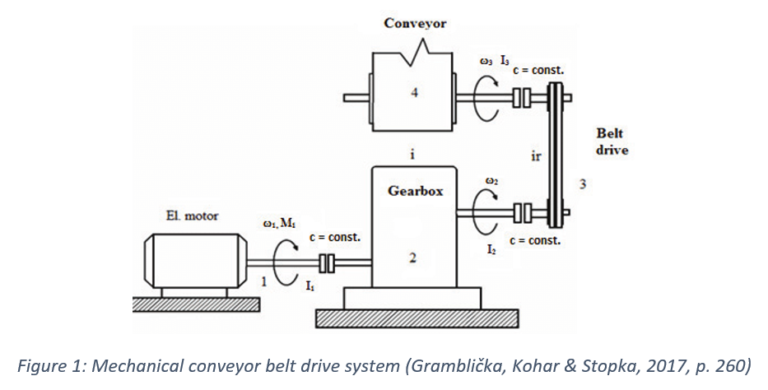
In the caption above, we have cited the page of the paper the image comes from using an APA-style citation. We would then need to add the full paper to the reference list at the end of the document:
Gramblička, S., Kohar, R., & Stopka, M. (2017). Dynamic analysis of mechanical conveyor drive system. Procedia Engineering , 192, 259–264. DOI: 10.1016/j.proeng.2017.06.045
Find this useful?
Subscribe to our newsletter and get writing tips from our editors straight to your inbox.
You can also cite an image directly if it not part of a larger publication or document. If we wanted to cite an image found online in APA referencing , for example, we would use the following format:
Surname, Initial(s). (Role). (Year). Title or description of image [Image format]. Retrieved from URL.
In practice, then, we could cite a photograph as follows:
Booth, S. (Photographer). (2014). Passengers [Digital image]. Retrieved from https://www.flickr.com/photos/stevebooth/35470947736/in/pool-best100only/
Make sure to check your style guide if you are not sure which referencing system to use when citing images in your work. And don’t forget to have your finished document proofread before you submit it for marking.
Need to Write An Excellent Essay?
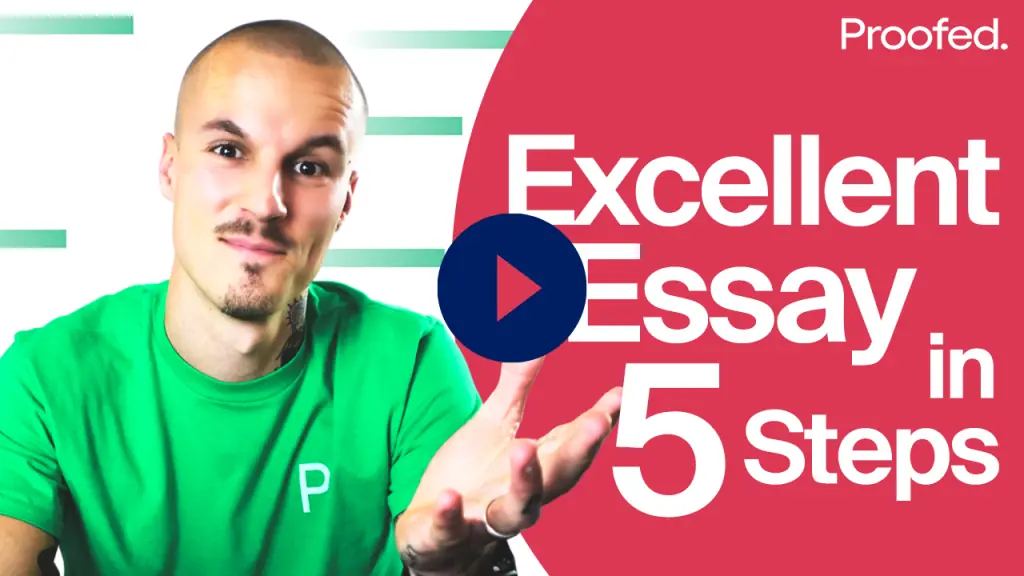
Share this article:
Post A New Comment
Get help from a language expert. Try our proofreading services for free.
4-minute read
The Benefits of Using an Online Proofreading Service
Proofreading is important to ensure your writing is clear and concise for your readers. Whether...
2-minute read
6 Online AI Presentation Maker Tools
Creating presentations can be time-consuming and frustrating. Trying to construct a visually appealing and informative...
What Is Market Research?
No matter your industry, conducting market research helps you keep up to date with shifting...
8 Press Release Distribution Services for Your Business
In a world where you need to stand out, press releases are key to being...
How to Get a Patent
In the United States, the US Patent and Trademarks Office issues patents. In the United...
The 5 Best Ecommerce Website Design Tools
A visually appealing and user-friendly website is essential for success in today’s competitive ecommerce landscape....

Make sure your writing is the best it can be with our expert English proofreading and editing.
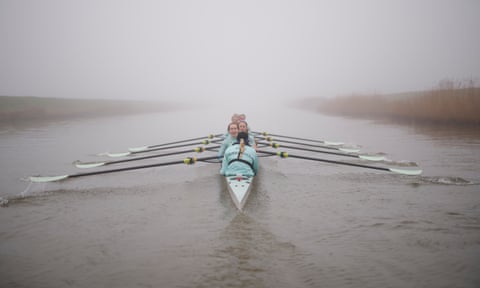
Pulling together: how Cambridge came to dominate the Boat Race – a photo essay
The race along the River Thames between England’s two greatest universities spans 195 years of rivalry and is now one of the world’s oldest and most famous amateur sporting events. Our photographer has been spending time with the Cambridge University Boat Club over the past few months as they prepare for 2024’s races
T he idea of a Boat Race between the two universities dates back to 1829, sparked into life by a conversation between Old Harrovian schoolfriends Charles Merivale, a student at the time at St John’s College Cambridge, and Charles Wordsworth who was at Christ Church Oxford. On 12 March that year, following a meeting of the newly formed Cambridge University Boat Club, a letter was sent to Oxford.
The University of Cambridge hereby challenge the University of Oxford to row a match at or near London each in an eight-oar boat during the Easter vacation.
From then, the Cambridge University Boat Club has existed to win just one race against just one opponent, something Cambridge has got very good at recently. Last year the Light Blues won every race: the open-weight men’s and women’s races, both reserve races, plus both lightweight races – six victories, no losses, an unprecedented clean sweep. Cambridge women’s open-weight boat, or blue boat, has won the last six Boat Races while the men’s equivalent have won five out of the last seven. In such an unpredictable race, where external factors can play a large part, this dominance is startling.

Thames trials
Rough water as the two women’s boats make their way along the River Thames near Putney Embankment during the Cambridge University Boat Race trials.
It’s a mid-December day by the River Thames. The sky and water merge together in a uniform battleship grey and the bitter north wind whips the tops off the waves. Outside a Putney boathouse two groups of tense-looking women dressed in duck-egg blue tops and black leggings with festive antlers in their hair are huddling together, perhaps for warmth, maybe for solidarity. The odd nervous bout of laughter breaks out. For some of them this is about to be their first experience of rowing on the Tideway, a baptism of fire on the famous stretch of London water where the Boat Race takes place. “Perfect conditions,” remarks Paddy Ryan, the head coach for Cambridge University women, for this is trial eights day, when friends in different boats duel for coveted spots in the top boat.
A couple of hours later these women along with their male equivalents will have pushed themselves to the absolute limit, so much so that several of the men are seen trying to throw up over the side of their boats at the finish under Chiswick Bridge. This may be brutal but it’s just the start. For these students the next few months are going to be incredibly tough, balancing academic work with training like a professional athlete. Through the harshest months of the year they will be focused on preparing for the end of March and a very simple goal: beating Oxford in the Boat Race.
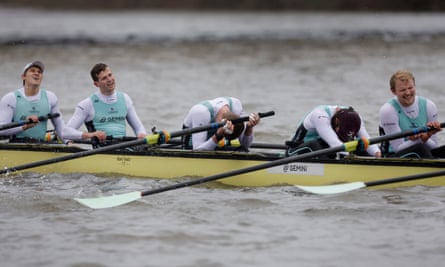
Agony for one of the men’s boats after the finish of the race near Chiswick Bridge during the Cambridge University Boat Race trials.

Ely early mornings
Two of the women’s boats head out in the early morning for a training session on the Great Ouse.
Early winter mornings on the banks of the Great Ouse, well before the sun has risen, can be pretty bleak. In the pitch black a batch of light blue minivans drop off the men and women rowers together at the sleek Ely boathouse that was opened in 2016 at the cost of £4.9m – it’s here that all Cambridge’s on-water training takes place. Very soon a fleet of boats carrying all the teams takes to the water for a training session that may last a couple of hours. Then it’s a quick change, a lift to the train station and back to Cambridge for morning lectures.

The women’s squad head into the Ely boathouse after a 6am drop-off.
As a rower descends the stairs to the bays where the boats are stored, there is a clear indication of why it was built and why they are there. “This is where we prepare to win Boat Races,” a sign says. Since this boathouse was built, Cambridge have won 30 of the 37 races across all categories.
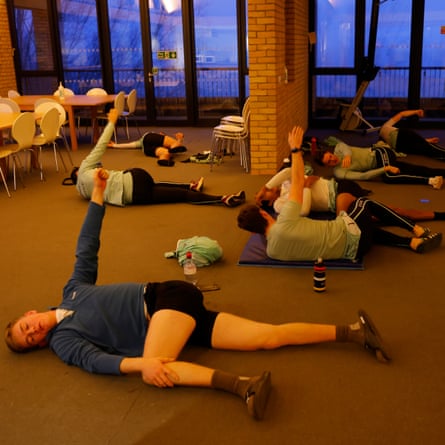
Top: The men’s squad stretch in the boathouse before an early morning training session and a member of the men’s blue boat descends the stairs into where the boats are kept. Below: One of the men’s teams set off for early morning training and the women’s blue boat rows past the women’s lightweight crew during a training session.
It’s a far cry from the old tin sheds with barely any heating and no showers. These current facilities are impressive, enabling the entire men’s and women’s squads to be there at the same time and get boats out.
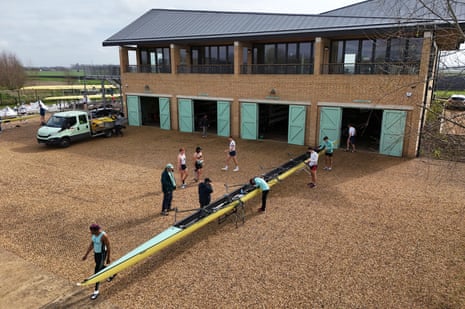
Top: The men’s blue boat prepare to derig their boat at their Ely training site. Above: The women’s blue boat put their vessel back in the boathouse after a training session on the Great Ouse.
But it’s not just the boathouse that has contributed so much, it’s also the stretch of water they train on. In a year when floods have affected so many parts of the country it has really come into its own. Paddy Ryan, the chief women’s coach, explains: “Along this stretch the river is actually higher than the surrounding land. The water levels are carefully managed by dikes and pumps. As a result we haven’t lost a single session to flooding. That’s not the case for Oxford. I believe their boathouse has been flooded multiple times this year, unable to get to their boats. We’ve had multiple storms but we’ve been able to row through them all.”

The men’s third boat practises on the Great Ouse.
It’s a flat, unforgiving landscape, especially in midwinter, definitely not the prettiest stretch of water, but Cambridge don’t care. Ryan says: “It might be a little dull on the viewing perspective but we could row on for 27km before needing to turn round. We have a 5km stretch that is marked out every 250m. We are lucky to have it.”

The men’s blue boat practise their starts on the long straight on the Great Ouse.

The sweat box
Members of the men’s squad check on their technique with the use of a mirror at the Goldie boathouse.
The old-fashioned Goldie boathouse is right in the centre of Cambridge perched on the banks of the River Cam. Built in 1873, its delicate exterior belies what goes on inside. This is the boat club’s pain cave, where the rowers sweat buckets, pushing themselves over and over again; it’s a good job the floor is rubberised and easy to wipe clean.
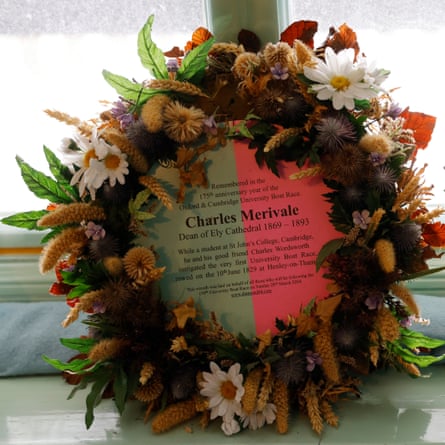
A wreath to Charles Merivale, the founder of the Boat Race, and wood panelling in the upstairs room at the Goldie boathouse which commemorates Cambridge crews that have competed in the Boat Race from 1829.

(Top) Seb Benzecry, men’s president of the Cambridge University Boat Club, and (above) Martin Amethier, a member of the reserve Goldie crew, sweat during sessions on ergo machines.

Iris Powell of the women’s blue boat (above) performs pull-ups during a training session.

Above left: Hannah Murphy, the cox of the women’s blue boat, urges on four of her crew (left to right) Gemma King, Megan Lee, Jenna Armstrong and Clare Hole, as they undertake a long session on the ergo machines. Above right: Kenny Coplan, a member of the men’s blue boat crew, looks exhausted then writes in his times after his session on an ergo machine (below).
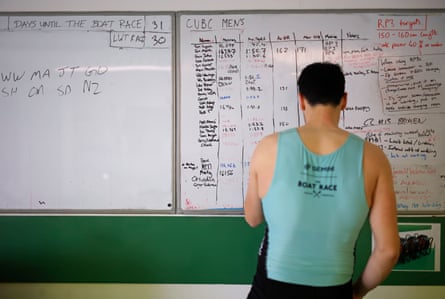
Brutal sessions on the various ergo machines, where thousands of metres are clocked and recorded, are a staple of the training regime set in place. If there is any slacking off the students just need to look up at one of the walls where a map of the Boat Race course hangs. The “S” shape of the Thames has been carefully coloured in the correct shade of blue and record timings for various key points on the course have been written in for both men and women. All but one record, and that one is shared, is held by Cambridge.

Paddy Ryan, the women’s chief coach, talks to the women’s blue boat during a training session on the River Great Ouse in February.
A key ingredient in any successful team is the coaching. Cambridge’s setup is stable and well established. Paddy Ryan is the chief women’s coach, a genial, tall Australian, he has been part of the women’s coaching team since 2013. The care and devotion to his squad is perfectly clear. “I have my notebook next to my bed so I can jot things down. I wake up in the middle of the night going: am I making the right decisions? I care about them as people and I need to manage them … We joke as coaches that we are teaching some of the smartest people on the planet how to pull on a stick.”
Rob Baker, the chief men’s coach, has Cambridge rowing in the blood. Born and bred in the city, his father was a university boatman for 25 years. He even married into the sport – his wife, Hayley, rowed for Cambridge as a lightweight – so it was no surprise that he became part of the coaching setup way back in 2001. He was the first full-time women’s coach in 2015 then moved to take over the men in 2018.
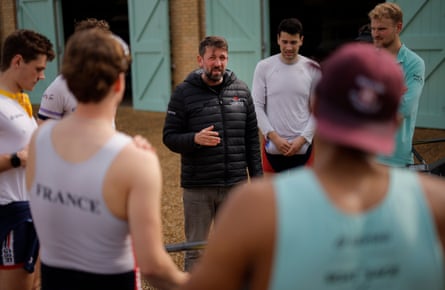
Rob Baker, the men’s chief coach, talks to his blue boat at their Ely training site.
Apart from an obvious role in the development of rowing skills, a key part of their job is making sure there is a balance for their student athletes. They understand they have to juggle training needs. “Every week we have a general plan,” says Baker, “but then someone might have an extra class or supervision they’ve got to do so we have to move around it. They are studying at one of the most competitive universities in the world with the highest standards so you’ve got to give them space to do that properly.” He goes on: “But when they get on the start line for their race, they’ll be just as competitive as if they were professionals.”
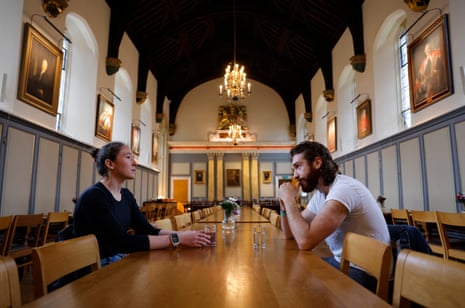
The presidents
Jenna Armstrong and Seb Benzecry discuss their plans in the Great Hall at Jesus College.
Every year one man and one woman are elected presidents to represent Cambridge University Boat Club. They are the captains and leaders, not only responsible for helping design the training programme in conjunction with the coaches but also making budgetary and tactical decisions along the way. This year both of them, Jenna Armstrong and Seb Benzecry, are from the same college, Jesus, which helps the communication between the two of them. They share ideas and knowledge, thoughts and worries. Their lives, for these intense few months, are a juggling act.
Armstrong is a 30-year-old from New Jersey, and doing a PhD in physiology. Once a very keen competitive junior skier she was forced to abandon her hopes of a career on the slopes after a number of serious knee injuries. She only started rowing in 2011 and only became aware of the Boat Race when she saw it on TV a couple of years later.
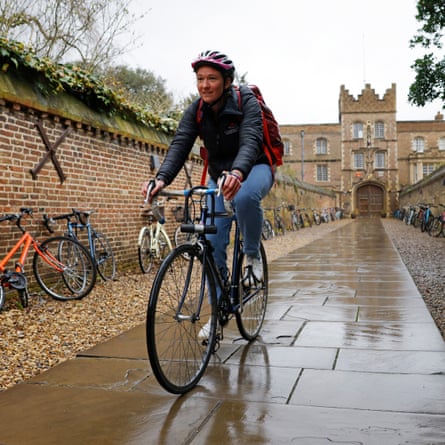
Jenna Armstrong, cycling down the Chimney, the grand entrance to Jesus College, to go to the other side of the city to carry out more of her PhD research at the department of physiology, development and neuroscience.
The research she carries out at the university labs could be turn out to be life-saving. “I study mitochondrial function in placentas from women from all over the world to learn how genetic and environmental factors during pregnancy can influence placental metabolism and impact the health of both mother and baby. I’m particularly interested in growth restriction which affects about 10% of babies worldwide. That can have lifelong implications for these babies and currently we don’t have any treatment for this.”
Benzecry, 27, is studying for a PhD in film and screen studies, and comes from a completely different rowing background. He grew up just a stone’s throw from the Boat Race course and went to a school on the banks of the Thames. This will be his 14th year of competitive rowing but his fourth and last Boat Race.
“ I remember one year my birthday fell on race day and we watched after my birthday party. Because we live fairly close to the course, I’ve always felt connected to the race.”

Seb Benzecry stands next to an Antony Gormley statue in the Quincentenary Library at Jesus College as he conducts research for his dissertation which forms part of his PhD in film and screen studies.
Talking about how hard it is to get the right balance between academic student life and rowing, Benzecry says: “I guess you have to accept there are many, many things you can’t do, you just don’t have time for during the season. You have to put the blinkers on.”
Armstrong says: “I have to be very prepared, very strategic and organised. I pack everything the night before, and then once I leave my room in the morning, I don’t go back. That allows me to go to training, go to the lab, go to training again. It’s surreal actually, to come to a place like Cambridge, have one of the best educations in the world on top of the most incredible rowing experiences in the world. We have a thing now in the boat, when we are doing something incredibly hard, I say this is my ideal Saturday, I wouldn’t want to be anywhere else. I would rather be here than in bed or on a date. And I make everyone else say it with me too. I’d rather be nowhere else.”
Benzecry states: “When it’s really bad, when training is so hard, we say Oxford aren’t doing this, they could never do this. It’s an incredibly powerful thing to be thinking we work harder than them, our culture is better than them. They don’t want to go hard as we do – they might think they do but they don’t, they just don’t have it.”
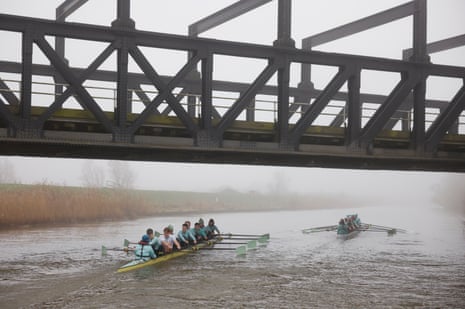
Integration
The men’s and women’s blue boats during a training session on the River Great Ouse in February.
Until 1 August 2020, there were three separate university boat clubs in Cambridge: one for open-weight men, one for lightweight men, and one for open-weight and lightweight women. Since they merged to become one club, it has undoubtedly helped with everyone sharing the same resources and motivating and inspiring one another. No one is more important and everyone has a key part to play in the result. This year, Oxford have followed suit.
Baker says: “I definitely feel, for the athletes themselves, it makes a big difference. They all feel like they’re contributing to one common goal. Every cog in the wheel has to do its job but for sure it feels like one big team on a mission.”
Benzecry explains: “We’re seeing each other train, we’re all out on the water at the same time, we’re supporting each other throughout the season, building a sense of momentum for the whole club towards the races. Everyone’s just inspiring each other all the time and I think that’s been such a sort of cultural shift for Cambridge.”
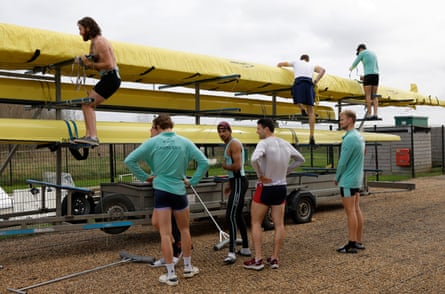
The men’s blue boat pack their craft on to a trailer at their Ely training site ready for the trip down to London for the Boat Race.
Siobhan Cassidy, the chair of the Boat Race, knows from first-hand how the integration has helped. She rowed for the Light Blues in 1995 and had a key role in the transition. “We could see the advantages of working together, collaborating as a bigger team, the positive impact we felt that could have on performance. But not just the output, actually the whole experience for the young people taking part.”
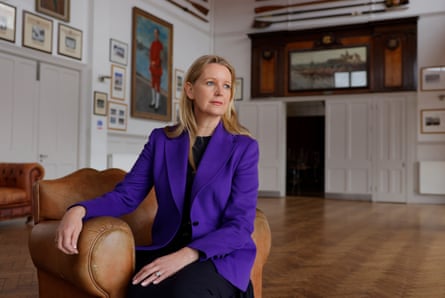
Siobhan Cassidy, the chair of the Boat Race, pictured at the Thames Rowing Club at Putney Embankment.
This Saturday, if the weather holds, an estimated 250,000 people, the vast majority of whom have no allegiance to one shade of blue or the other, will pack the banks of the Thames to see these races. It’s one of the largest free events in Britain. Broadcast live on BBC One, the race is also beamed to 200 countries across the world.
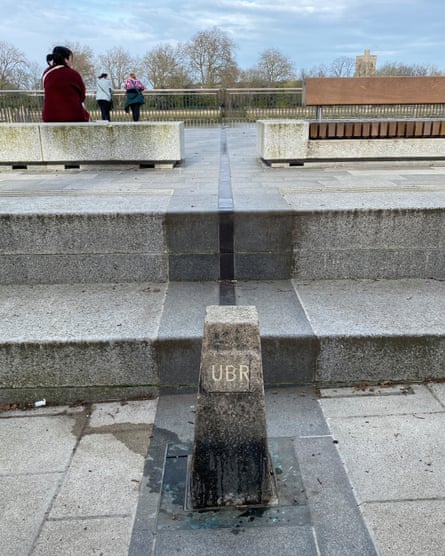
The starting stone for the University Boat Race and pavement inscription: “The best leveller is the river we have in common” at Putney Embankment.
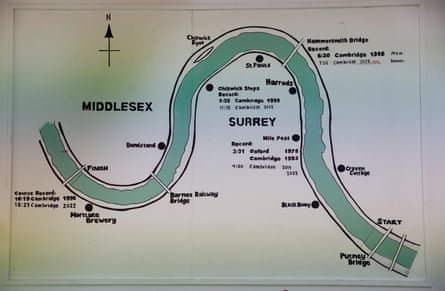
A map of the Boat Race course at the Goldie boathouse, with the Thames coloured in Cambridge blue and record timings written in for men and women showing almost total Cambridge dominance.
A sporting pinnacle being contested on a fast-flowing, unpredictable river by two teams of university students – it’s pretty bizarre. But maybe it’s that quirkiness that keeps the race, after almost two hundred years, still going strong. And even more bizarre to think that Cambridge, the current dominant force in the Boat Race, a sporting event that can’t shrug off its elitist stereotype, owes so much of that success to such egalitarian principles.
- The Guardian picture essay
- The Boat Race
- University of Cambridge
- Photography
Most viewed

IMAGES
VIDEO
COMMENTS
Make sure to directly reference the image in the text of your essay. If you have included an image to illustrate a point, for instance, you would include something along the lines of 'An example of this can be seen in Figure 1'. The key, then, is that images in an essay are not just decoration. Rather, they should fit with and add to the ...
To insert an image into the text using Microsoft Word: Place the cursor where you want to add a picture. Go to Insert > Pictures. Click on This Device to add pictures from your own computer or select Online Pictures to search for a picture from the internet. Select the image you wish to use and click Insert.
Tables, Images, & Appendices. For some papers and reports, you may choose to add a table, graph, chart, or image within the body of the draft. Or you may choose to include an appendix at the end of your paper. These can help to provide a visual representation of data or other information that you wish to relay to your reader.
There are two ways to organize your images: either place them in your text next to the paragraph where you discuss them (Figure 1), or put them all together at the end of the essay (Figure 2). Captions Images always need captions. Captions should do two things; label the image and tell us the image's source.
It's acceptable to add an image in an essay to illustrate an argument for more clarity. Images can be useful when explaining a process, showing an example, or in the instance when you want to grab your reader's attention. Be advised that you must follow the accepted citation rules when including an image in the essay.
If you include an image directly in your paper, it should be labeled "Fig." (short for "Figure"), given a number, and presented in the MLA figure format. Directly below the image, place a centered caption starting with the figure label and number (e.g. "Fig. 2"), then a period. For the rest of the caption, you have two options:
While writers arrange, or put together, a story, essay, or poem to take place over time—that is, the time readers need to follow the text, line by line, through a number of pages—image creators arrange pictures in the two-dimensional space of their viewfinder, paper, or canvas to invite viewers to read in space rather than time. This ...
This video explains how to include and cite an image in an essay following MLA 8 guidelines.
like any other source within your essay, the full reference is included in your reference list. If you found the figure or table in a journal article, follow the guidance for referencing an article. If you found it on a webpage, reference the webpage. If the image is a film still, reference the film. Where do I find how to reference my source ...
2. Include a marker, such as Image 1. or Figure 1., and in the reference section, include full citation information with the corresponding number. 3. Include a complete citation (whatever the required format, such as APA) below the image. 4. Below the image, include the link to the online image location. 5.
An APA image citation includes the creator's name, the year, the image title and format (e.g. painting, photograph, map), and the location where you accessed or viewed the image. Last name, Initials. ( Year ). Image title [ Format ]. Site Name. or Museum, Location. URL.
Auditory imagery engages the sense of hearing. This is the way things sound. Literary devices such as onomatopoeia and alliteration can help create sounds in writing. 5. Olfactory imagery engages the sense of smell. Scent is one of the most direct triggers of memory and emotion, but can be difficult to write about.
Make sure to reference any images you use in the text of your essay. If you have included an image to illustrate a point, for instance, you would include something along the lines of "An example of this can be seen in Figure 1.". The key, then, is that images in an essay are not just decoration. Rather, they should fit with and add to the ...
Shark in a library image generated using an AI tool (Craiyon, AI Image Generator (pers. comm.) 14 July 2022). Online images and resources for your work The library has compiled a list of useful audio-visual resources, including images, that can be used for essays or assignments.
The photographer uses the image of children to symbolize the future. The non-human elements in the photo symbolize life and planet Earth. The author connects ideas represented by these images to get the message across." Step 5: Write the Body of Your Essay. At this point, we have everything we need to write the rest of the essay.
Citing an image in APA Style. In an APA Style reference entry for an image found on a website, write the image title in italics, followed by a description of its format in square brackets. Include the name of the site and the URL. The APA in-text citation just includes the photographer's name and the year. APA format. Author last name, Initials.
However, it's considered good form to allow your audience to find your images. You should make an attribution in a caption beneath or adjacent to the image that states the title/name of the image, the author/creator (if you can find it), the source, and the license. Then h yperlink the title of the image and author to the source of the image ...
Exploring the Picture Essay: Tips, Best Practices, and Examples. April 18, 2023. Words by Jeff Cardello. A picture essay lets you harness the power of images to tell stories, evoke emotions, and convey a sense of place, time, and perspective. Picture essays drop viewers right into the action, letting them see things through the camera's lens ...
A photo essay is a series of images that share an overarching theme as well as a visual and technical coherence to tell a story. Some people refer to a photo essay as a photo series or a photo story - this often happens in photography competitions. Photographic history is full of famous photo essays.
1. If you include any images in your document, also include a figure caption. See the "Positioning images in your document" box for more information. 2. If you refer to any visual material, i.e. art, design or architecture, you have seen in person and you are not including an image of it in your document, provide a detailed in-text citation or ...
4. Your Own Images. As far as using images legally online, this is always going to be your best option. Creating your own images is a straightforward and simple way to avoid copyright infringement ...
In Chicago style, when you don't just refer to an image but actually include it in your (research) paper, the image should be formatted as a figure. Place the figure before or after the first paragraph where it is mentioned. Refer to figures by their numbers in the text (e.g., "see fig. 1"). Below the figure, place a caption providing the ...
Chandan Khanna/Agence France-Presse — Getty Images. ... The night before one of Mr. Glover's interviews at NASA for the 2013 class, he was asked to write an essay. The title: "Girls Like ...
All images in your essay should come with clear captions (e.g. 'Figure 1' plus a title or description). Without these, your reader may not know how images relate to the surrounding text. Have you mentioned the image in the text? Make sure to reference any images you use in the text of your essay. If you have included an image to illustrate ...
View image in fullscreen Two of the women's boats head out in the early morning for a training session on the Great Ouse. Early winter mornings on the banks of the Great Ouse, well before the ...
Donald Trump's violent nihilism is exposed in his latest video. The Australian Electoral Commission would expunge such an image, but Trump's worst outrages are protected by the US First Amendment.